Which Meat Is Better the Back or Rear of a Beef
Through this article and beef cuts chart and diagram, you'll learn about all the popular cuts of beef from front to back, what they're good for, and how to cook them.
We'll cover the relevant terminology, throw in a few buying tips, give you an idea of what to expect when you get up to the register to pay, and provide a recipe for every single cut to cook on your grill or smoker.
Many people have only a basic knowledge of cuts of beef. That's why so many restaurants include a guide to the steaks on the menu. There are more than 20 steaks by my count, not to mention ribs, brisket, roasts, and so on.
Owning a great grill is terrific, but to wow your friends and earn the right to wear a cheesy apron, you should also know your cuts of meat, including all beef cuts.
Of course, the real reason is, so you can try new things, and expand your skills and your repertoire.
Is your mouth watering yet? Then let's get a moo-ve on!
Note: All beef cuts images provided courtesy of BeefItsWhatsForDinner.com
Contents (Jump to Topic)
- 1 Beef Cuts Chart
- 2 Cuts of Beef Diagram and Infographic
- 3 The Meat of the Article — All the Different Beef Cuts
- 4 Chuck
- 4.1 Blade Chuck Roast
- 4.2 Blade Chuck Steak
- 4.3 7-Bone Chuck Roast
- 4.4 Chuck Center Roast
- 4.5 Chuck Center Steak
- 4.6 Denver Steak
- 4.7 Chuck Eye Roast
- 4.8 Chuck Eye Steak
- 4.9 Country-Style Ribs
- 4.10 Cross Rib Chuck Roast
- 4.11 Shoulder Roast
- 4.12 Shoulder Steak
- 4.13 Ranch Steak
- 4.14 Flat Iron Steak
- 4.15 Top Blade Steak
- 4.16 Petite Tender Roast
- 4.17 Petite Tender Medallions
- 4.18 Chuck Short Ribs, Bone-in
- 5 Rib
- 5.1 Ribeye Roast, Bone-in or Boneless
- 5.2 Ribeye Steak, Bone-in or Boneless
- 5.3 Back Ribs
- 5.4 Ribeye Cap Steak
- 5.5 Ribeye Petite Roast
- 5.6 Ribeye Filet
- 6 Loin
- 6.1 Porterhouse Steak
- 6.2 T-bone Steak
- 6.3 Strip Steak, Bone-in or Boneless
- 6.4 Strip Petite Roast
- 6.5 Strip Filet
- 6.6 Tenderloin Roast
- 6.7 Tenderloin Filet
- 7 Sirloin
- 7.1 Top Sirloin Steak
- 7.2 Top Sirloin Petite Roast
- 7.3 Top Sirloin Filet
- 7.4 Coulotte Roast
- 7.5 Tri-Tip Roast
- 7.6 Tri-Tip Steak
- 7.7 Petite Sirloin Steak
- 7.8 Bavette (Sirloin Bavette)
- 8 Round
- 8.1 Top Round Steak
- 8.2 Bottom Round Roast
- 8.3 Western Steak / Bottom Round Steak
- 8.4 Eye of Round Roast
- 8.5 Eye of Round Steak
- 9 Brisket
- 9.1 Brisket Flat
- 9.2 Brisket Point
- 10 Plate & Flank
- 10.1 Inside Skirt Steak
- 10.2 Outside Skirt Steak
- 10.3 Hanger Steak
- 10.4 Flank Steak
- 10.5 Plate Short Ribs, Bone-In
- 11 Other
- 11.1 Kabobs
- 11.2 Strips
- 11.3 Cubed Steak
- 11.4 Stew Meat
- 11.5 Shank Cross Cut
- 11.6 Ground Beef and Ground Beef Patties
- 12 Outdoor Cooking Techniques
- 12.1 Direct Grilling/Searing
- 12.2 Low 'n' Slow and Smoking
- 12.3 Indirect Grilling/Roasting
- 12.4 Dutch Oven on the Grill
- 12.5 Wok on the Grill
- 12.6 Texas Crutch
- 13 Taking Traditional Cooking Methods Outside to Your Grill
- 13.1 Grilling or Broiling = Direct Grill and Sear
- 13.2 Slow Cooking = Low 'n' Slow
- 13.3 Stir Fry = Cooking With a Wok on the Grill
- 13.4 Roast = Indirect Grill and Roast
- 13.5 Skillet = Direct Grill and Sear
- 13.6 Skillet to Oven = Direct to Indirect Heat
- 13.7 Stewing or Pot Roasting = Searing and Finishing in a Dutch Oven
- 13.8 Braise = Low 'n' slow, OR grill and Texas Crutch, OR Braise in a Dutch Oven
- 14 The Final Cut
Beef Cuts Chart
This first beef cuts chart is for those who'd like an at-a-glance overview of every cut of beef, with relative cost, how to cook them, and more.
Please click the following image to open it full screen in a new window!
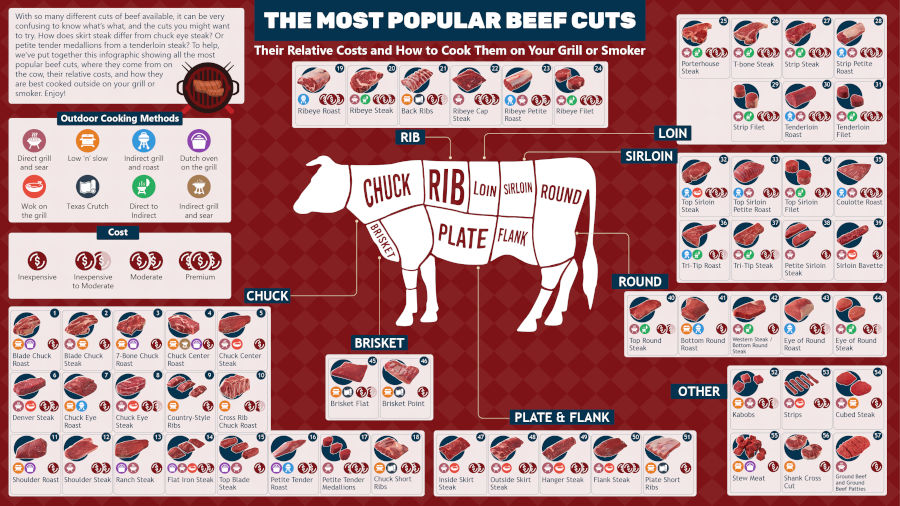
Cuts of Beef Diagram and Infographic
Before we get into the in-depth article on all the most popular beef cuts, here is an overview infographic showing where every cut of beef comes from on the cow, recommended methods for cooking outdoors, and their relative costs.
We couldn't add the actual costs of each cut, as it varies wildly and would soon be incorrect. So instead, we show you their price relative to each other with a sliding scale from inexpensive, through moderate, and to premium cost.

The Meat of the Article — All the Different Beef Cuts
Entirely unavoidable pun out of the way early. Moving on.
Before we dive right in, here's a video that provides an overview of the major sections of a side of beef while a butcher skillfully creates all the different sub-primal cuts from the primal cuts of beef.
A side of beef is divided into parts known as "primal cuts." From the primals, butchering requires taking the familiar steaks, roasts and other "sub-primals."
The number and names of the primals vary from country to country. For our purposes, we're dividing our instructional cow into seven primals, largely in keeping with the American system of beef labeling.
We've also added an "others" section for some special cuts.
Let's begin our beef tour from the front, shall we?
Chuck
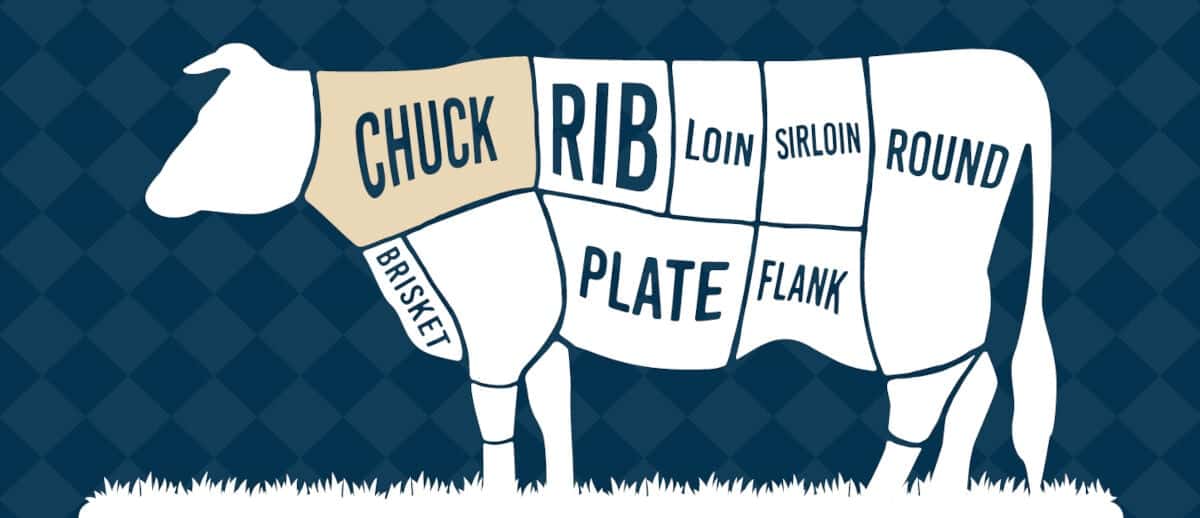
Cuts in the beef Chuck category originate from the 'chuck primal', in the neck and shoulder area.
This zone provides a nice balance between flavor and economy, making it a desirable part of the beef. Unfortunately, there tends to be more fat in this area than in other sections, and the meat is sometimes a bit tough.
Bone and gristle are also abundant here. A lot of cuts come from the Chuck, and no single cooking style does them all justice.
Blade Chuck Roast
Alternative names: Blade Chuck Pot Roast; Chuck 7-bone Pot Roast; Chuck Arm Pot Roast; Chuck Blade Pot Roast; Chuck pot roast; Chuck Roast 1st Cut; Chuck Roast Blade Cut; Shoulder Pot Roast
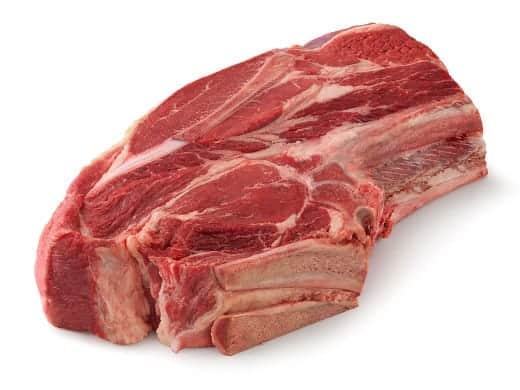
As the 'blade' name implies, this cut is found in the shoulder area.
It's a relatively cheap yet flavorful cut, but not especially tender depending on how it's cooked, requiring true low 'n' slow cooking to break down all the connective tissues, resulting in moist and tender meat.
Look for nice marbling in a good roast, but watch out for and potentially trim excess fat. Weight is usually around 2.5 – 4 lbs.
Cost: Inexpensive.
Best for: Low 'n' slow, or braise in a Dutch oven.
Chef's Tip: Try an acidic fluid for braising to increase tenderness, such as citrus fruit juice, vinegar, or red wine.
Blade Chuck Roast Recipe
- Swap the oven for indirect heat in your grill or smoker to recreate this almost festive flavored recipe: Star anise and orange glazed beef blade roast.
Blade Chuck Steak
Alternative names: Boneless Blade Steak 1st Cut; Deluxe Blade Steak
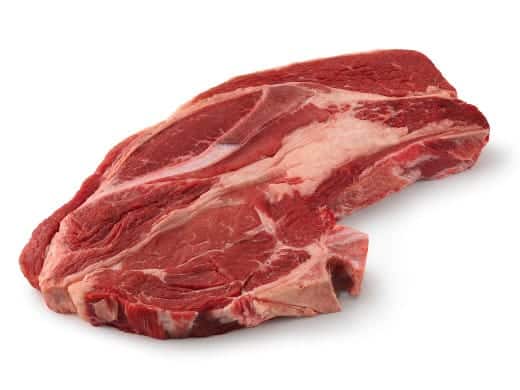
Another cut from the shoulder, this less popular steak is typically bisected by a ribbon of connective tissue.
Once cooked, this is what most of us call "gristle." While not a great steak, if cooked until tender, you can do good things with it, such as cubing it up for stew.
If you like to shop economically, marinating to achieve tenderness in less desirable tough cuts, this is an excellent steak to experiment with.
Head over to our guide on the blade chuck steak for more details.
Cost: Inexpensive.
Best for: Direct grill and sear, or low 'n' slow.
Chef's Tip: Cross-cut the cooked meat to leave only a small bit of gristle at the end of each serving.
Blade Chuck Steak Recipe to Try
- GimmeDelicious Lemon Garlic Steak
7-Bone Chuck Roast
Alternative names: 7 Bone; 7-Bone Pot Roast; 7-Bone Roast; Center Cut Pot Roast; Chuck 7 Bone Pot Roast; Chuck 7-Bone Pot Roast; Chuck Arm Pot Roast; Chuck Blade Roast Bone-In; Chuck Roast Center Cut
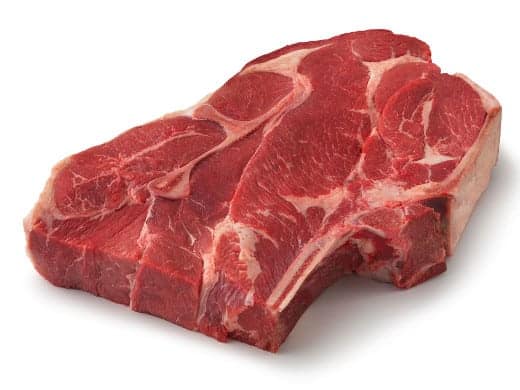
If you're expecting a veritable bone-yard in this cut, you'll be disappointed — or more likely, pleased.
This cut doesn't contain 7 bones, it actually gets its name from the shape of the single large bone found in the cut, said to look like the number 7.
Nice and flavorful, usually with thorough marbling. Makes a delicious pot roast beef if cooked slowly. This can be a massive cut of meat, perhaps 15" in length and almost as wide.
Cost: Inexpensive.
Best for: Low 'n' slow, or searing and finishing in a Dutch oven.
Chef's Tip: A 7-Bone cut to include part of the backbone may have extra flavor thanks to the extra bone.
7-Bone Chuck Roast Recipe for You to Try
- Oak Smoked 7 Bone Chuck Roast
Chuck Center Roast
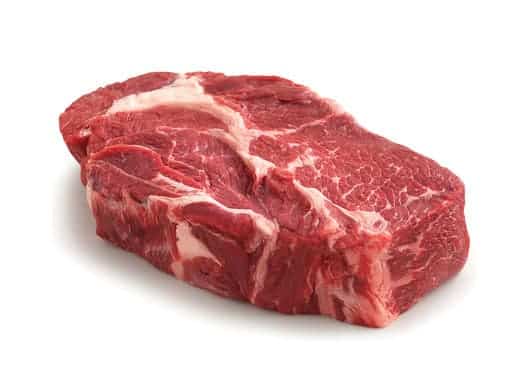
Cut from the same areas the 7-Bone, but lacking the bone, this is a lovely looking piece of meat. It's tough but tasty, and, like other beef Chuck cuts, is best as a pot roast.
Weighs in between 8 – 14 lbs. uncooked, and may include the wonderfully named Chuck Eye Roll.
Cost: Inexpensive
Best for: Low 'n' slow, or indirect grill and sear, or searing and finishing in a Dutch oven.
Chef's Tip: Probably the most popular choice for the classic Sunday roast beef!
Chuck Center Roast Recipe
- Garlic and tri-pepper crusted beef roast with balsamic sauce
Chuck Center Steak
Alternative names: Beef Shoulder Center Steak; Center Cut Chuck Steak; Ranch Steak; Shoulder Center Steak; Shoulder, Arm Steak
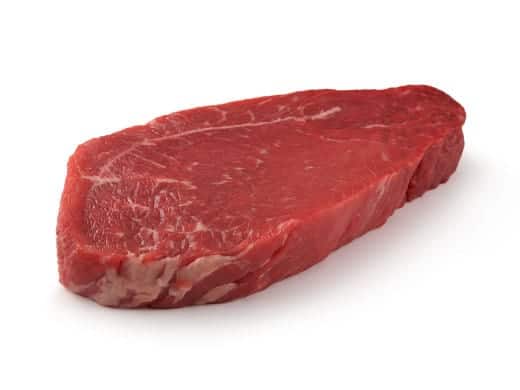
This low-cost steak is cut from under the 7-Bone.
Although a likely candidate for some form of slow cooking, you might try grilling this one after marinating. Great for adding sliced to stir-fry, as well.
Cost: Inexpensive.
Best for: Direct grill and sear, or cooking with a Wok on the grill.
Chef's Tip: Very lean, so not packing huge flavor. Therefore, can benefit from an overnight marinade to boost it.
Chuck Center Steak Recipe
- Teriyaki flavored grilled steak
Denver Steak
Alternative names: Chuck Under Blade Center Steak; Chuck Under Blade Steak; Denver Cut
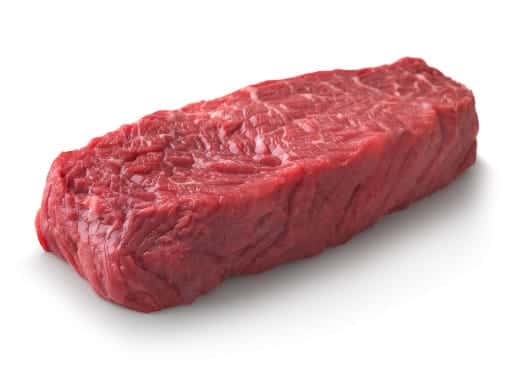
Unlike most of the shoulder muscles, the muscle from which this steak is cut — The center of the under blade — doesn't get much of a workout, so it's more tender than most Chuck cuts.
Marbling is evident in a good cut, and the flavor is intense. A highly recommended cut of beef.
Learn more in our article: What is Denver steak.
Cost: Moderate.
Best for: Direct grill and sear, or cooking with a Wok on the grill.
Chef's Tip: Depending on the butcher's cut, this steak can be a bit tough. Avoid overcooking to maximize tenderness.
A Great Denver Steak Recipe for You to Try
- Grilled Denver Steak and Tomatoes with Caper-Mustard Vinaigrette
Chuck Eye Roast
Alternative names: Boneless Chuck Fillet; Boneless Chuck Roll; Chuck Center Roast; Chuck Eye Roll; Chuck Roll; Inside Chuck Roll
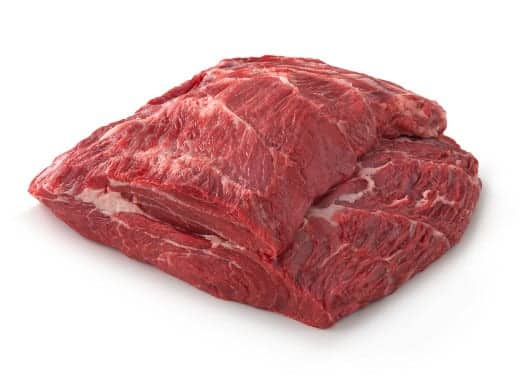
A compact and flavorful roast cut from the center of the chuck, but sometimes hard to find at the butcher.
It's a continuation of the muscle from which the wonderful ribeye is cut, and it's lean, but tender, for a chuck cut.
Cost: Inexpensive.
Best for: Low 'n' slow, or indirect grill and roast.
Chef's Tip: Tender enough to 'shred' for pulled beef as an alternative serving style, or for adding to other dishes.
To learn more, check out our detailed guide to the chuck eye roast.
Chuck Eye Roast Recipe We Recommend
- Recreate oven temps with indirect heat on your grill for this one: Garlic and tri-pepper-crusted beef roast with balsamic sauce
Chuck Eye Steak
Alternative names: Boneless Chuck Filet Steak; Boneless Chuck Slices; Boneless Steak Bottom Chuck; Chuck Filet; Delmonico Steak; London Broil; Shoulder Steak
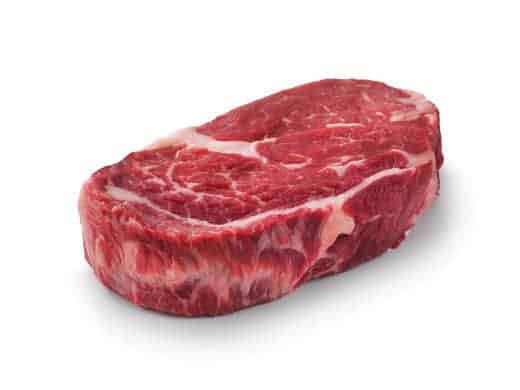
If this steak were just one rib further back, it would be a rib-eye! So as you might imagine, this is a desirable steak being not too expensive, but very tasty.
There is only one Chuck Eye steak per side of beef, so it's not always waiting for you at the butcher. Great choice when you want a steak, but the wallet is a bit light if you can get it.
Cost: Inexpensive to Moderate.
Best for: Direct grill and sear, or cooking with a Wok on the grill.
Chef's Tip: Don't cook past medium to maintain tenderness.
For more details, check out our guide to the Chuck Eye Steak.
How to Cook a Chuck Eye Steak
- No-nonsense chuck eye steak
Country-Style Ribs
Alternative names: Chuck Ribs
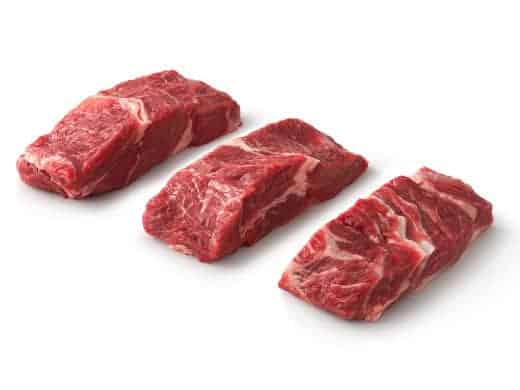
Beef ribs without the ribs! That's right, there are no bones in these ribs because they're not actually ribs. Confused?
They are in fact strips of chuck roll cut down to size. But, you can cook them just like beef ribs, which means they benefit from low n slow cooking to break down all the tough connective tissues inside and then become moist, tender and unctuous.
Head over to our country ribs guide for more details!
Cost: Inexpensive.
Best for: Low 'n' slow.
Chef's Tip: Since there aren't any bones, and the meat is tender, this is a good cut for slicing thinly to put on a sandwich.
Country Style Rib Recipe
- Asian sweet and spicy ribs
Cross Rib Chuck Roast
Alternative names: Boston Cut; Bread and Butter Cut; Cross Rib Roast; English Cut Roast; English Roll; Thick Rib Roast
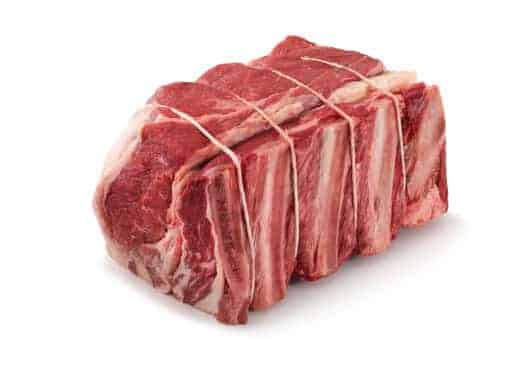
I always thought cows had four legs, but apparently, this roast comes from the arm. I suppose that makes sense, given that there's a shoulder in the vicinity. The Cross Rib Chuck roast is found between the blade and the brisket and has a fair amount of connective tissue and a layer of fat.
Cost: Inexpensive to Moderate.
Best for: Low 'n' slow.
Chef's Tip: Might be worth taking the time to tenderize this cut before dry cooking.
Cross Rib Chuck Roast Recipe
- Roasted with garlic, rosemary and thyme
Shoulder Roast
Alternative names: Shoulder clod roast
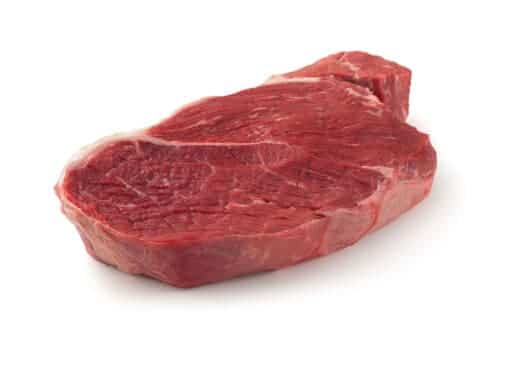
One of the toughest cuts, but still great for a pot roast. This is one of the few lean cuts from the Chuck. However, like many cuts in the Chuck, there is a fair bit of connective tissue to contend with. It's boneless, so it's easy to cut and serve.
Cost: Inexpensive.
Best for: Low 'n' slow, or braised in a Dutch oven.
Chef's Tip: Dries out fairly easily, but if cooked right, it slices very nicely for a sophisticated presentation.
Shoulder Roast Recipe
- Texas Clod (Barbecued Beef Shoulder)
Shoulder Steak
Alternative names: English Steak; London Broil; Shoulder Steak; Shoulder Steak Half Cut
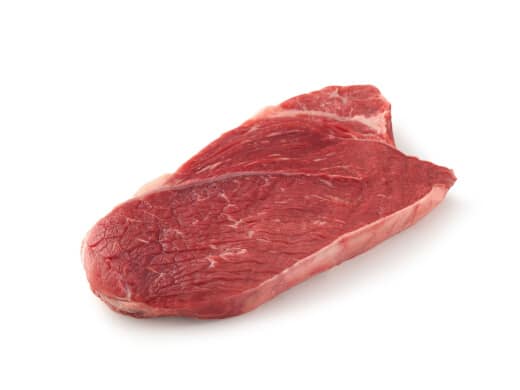
A boneless steak sometimes referred to by other names such as London Broil, or Swiss steak.
Lean and full of flavor, but with a lot of connective tissue. Usually cut about an inch thick, and weighing 10 ounces before it hits the grill.
For more details, clink on over to our shoulder steak guide.
Cost: Moderate.
Best for: Direct grill and sear.
Chef's Tip: The Texas Beef Council (who sound like they should know) recommends marinating before grilling.
Shoulder Steak Recipe to Try
- Grilled Chuck Steak with Compound Garlic Butter
Ranch Steak
Alternative names: Arm Steak; Beef Shoulder Center (Ranch) Steak, Boneless; Chuck Steak Center Cut; Ranch Cut; Ranch Steak; Shoulder Center Steak; Shoulder Center Steak, Boneless; Shoulder, Arm Steak
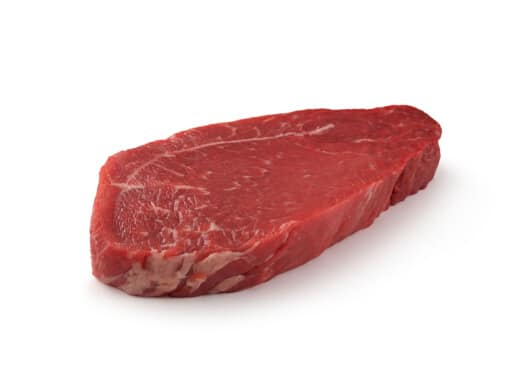
Pros compare this steak to the Top Sirloin, which is high praise for a cut from the Chuck.
It's always a boneless steak cut 0.75 – 1" thick from near the Shoulder Roast and weighing around 10 oz. Sadly, its catchy name is not a holdover from the days of cowboys and chuck wagons but is, in fact, a marketing gimmick employed by cunning grocers to promote familiarity.
If you'd like to learn more, check our article: What is ranch steak?
Cost: Inexpensive.
Best for: Searing and then finishing in a Dutch oven, or direct grill and sear.
Chef's Tip: Shouldn't be cooked past medium if using a dry cooking method, but will turn out juicy.
Ranch Steak Recipe
- Barbecued ranch steaks
Flat Iron Steak
Alternative names: Boneless Top Chuck Steak; Book Steak; Butler Steak; Flat Iron Steak; Flatiron; Flatiron Steak; Lifter Steak ; Petite Steak; Shoulder Top Blade Steak; Shoulder Top Blade Steak, Boneless; Shoulder Top Blade Steak, Boneless, Flat Iron; Top Blade Steak; Top Blade Steak, Boneless
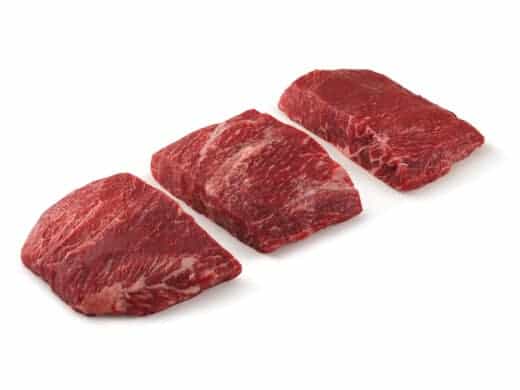
For a Chuck steak, the Flat Iron is reasonably tender. It's boneless, having been cut from under the 7-Bone roast, and has a lot of marbling. Works great in a stew!
Interestingly, it was the brainchild of teams from the University of Nebraska, and the University of Florida to find a use for the Top Blade roast, a cut typically wasted because of an excess of connective tissue.
You can learn far more in our guide to flat-iron steak.
Cost: Moderate.
Best for: Searing and then finishing in a Dutch oven, direct grill, and sear, or cooking with a Wok on the grill.
Chef's Tip: Keep your heat medium-high, and aim for medium rare.
Flat Iron Steak Recipe
- Grilled Flat Iron Steak with Blue Cheese-Chive Butter
Top Blade Steak
Alternative names: Boneless Top Chuck Steak ; Book Steak ; Butler Steak; Flat Iron; Flat Iron Roast; Lifter Steak; Petite Steak; Top Blade
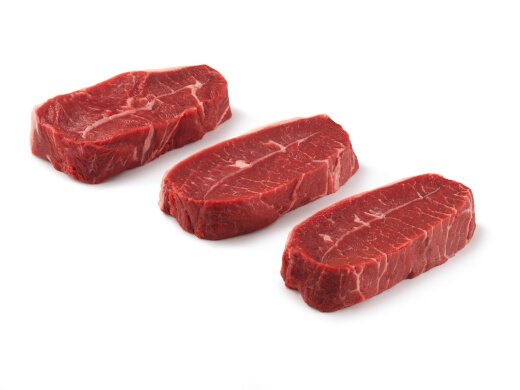
This is the same steak as the Flat Iron, but with the connective tissue still in place. You'll have to do a little extra cutting, but the flavor and the savings might make it worth your while.
Learn more in our guide to the top blade steak.
Cost: Inexpensive.
Best for: Searing and then finishing in a Dutch oven, or direct grill and sear.
Chef's Tip: Popular choice for fajitas, as the Top Blade is rich in flavor.
Top Blade Steak Recipe to Try
- Balsamic marinated top blade steaks
Petite Tender Roast
Alternative names: Butcher's Steak; Chuck Shoulder Tender ; Petite Tender Medallions ; Shoulder Petite Tender; Shoulder Petite Tender Roast Boneless; Shoulder Tender; Shoulder Tender Medallions
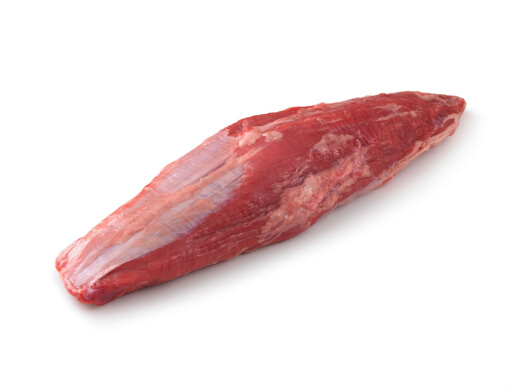
Surprisingly, this is one of the most tender cuts anywhere on a side of beef. This lean cut costs about half as much as a Tenderloin but is of comparable quality. Great texture and delicious flavor — not just another pot roaster from the Chuck!
Cost: Moderate.
Best for: Searing and then finishing in a Dutch oven, or indirect grill and roast.
Chef's Tip: Best enjoyed medium rare to appreciate the flavor profile, but shouldn't dry out if cooked more thoroughly.
Petite Tender Roast Recipe
- Petite Tender Steak with Roasted Garlic Aioli
Petite Tender Medallions
Alternative names: Chuck Shoulder Tender ; Petite Tender Medallions; Shoulder Petite Tender Medallions; Shoulder Tender Medallions
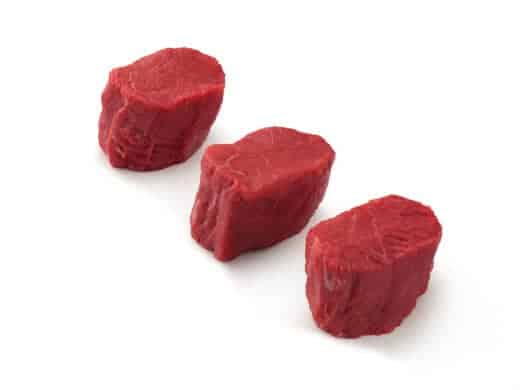
Really, this is just the Petite Tender Roast cut into medallions. The muscle the Petite Tender comes from is difficult to remove from the Chuck, so it's not commonly offered for sale. Combine this with extra cutting to make medallions, and you've got the most expensive part of the Chuck. But so, so lean and tasty!
Cost: Premium.
Best for: Direct grill and sear.
Chef's Tip: Lie, and tell your guests it's Filet Mignon.
Petite Tender Medallion Recipe to Try
- Petite Tender Medallions with Fresh Herbs and Lemon Cream
Chuck Short Ribs, Bone-in
Alternative names: Beef Ribs; Braising Ribs; Short Ribs
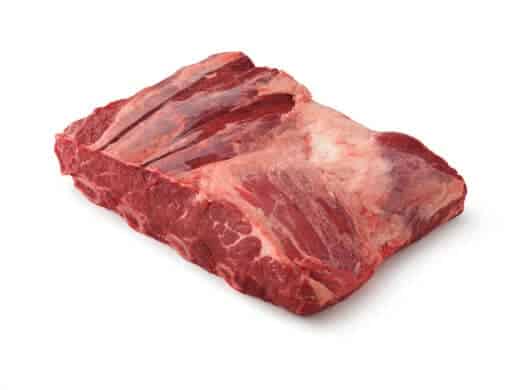
One could actually cut these ribs to any desired size; feel free to serve long Short Ribs, if you enjoy a little irony with your meal. It's a tough and chewy cut, but there's a lot of flavor to be had, making them worth the chew. Beef short ribs are popular internationally and are commonly found in dishes from the U.S., France, and Korea.
Cost: Moderate
Best for: Low 'n' slow.
Chef's Tip: Short ribs are easily deboned and served as small filets.
Chuck Short Rib Recipe
- Barbecued Beef Short Ribs
Rib
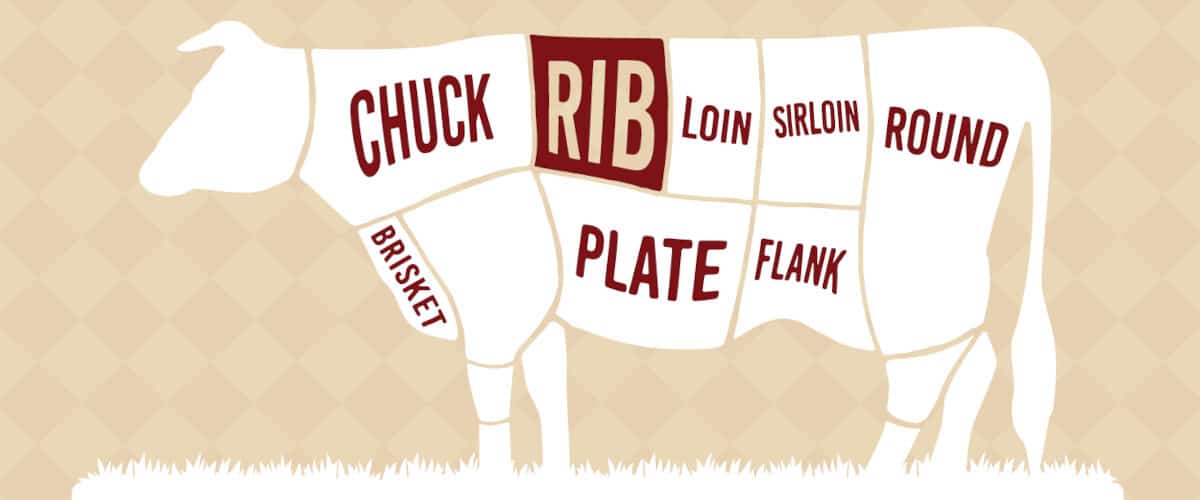
A lot of good meat comes from the Rib section, notably the back ribs so many of us love. Steaks and roasts are also found here, in what you'd call the front of the middle of the beef.
By and large, cuts from the Rib zone are best cooked 'low and slow.' Most Rib zone cuts are expensive, except for, ironically, the back ribs.
Ribeye Roast, Bone-in or Boneless
Alternative names: Newport Roast; Prime Rib; Rib Roast; Rib Roast Bone-In, Small End; Rib Roast, Oven-Ready; Standing Rib Roast
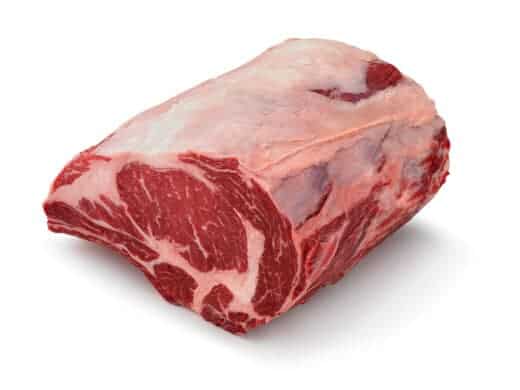
This is a moist, tender, and fatty cut from a part of the cow that sees little exercise. It's so moist, in fact, that dry heat is all you need to cook it to juicy perfection. It's compact, cooks quickly, and is popularly used in many Asian dishes. Many people feel leaving in the bones enhances the flavor.
Cost: Premium.
Best for: Indirect grill and roast.
Chef's Tip: The bones make excellent guides for cutting the roast into portions. Ask for the "first cut," and you'll get the first four ribs of the desirable Loin area included in your roast.
Ribeye Roast Recipe
- Standing Rib Roast Recipe | Bobby Flay
Ribeye Steak, Bone-in or Boneless
Alternative names: Ribeye Roll Steak; Ribeye Steak, Bone-In; Ribeye Steak, Lip-On, Boneless; Cowboy steak, Tomahawk steak
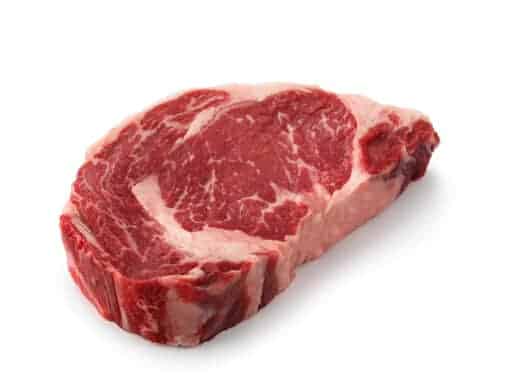
A very tender and delicious steak that may be anywhere from 8 to 20 oz., depending on the thickness of the cut. Bone enthusiasts believe the bone enhances the flavor during cooking.
The boneless version is a premium steak cut from the small end of the Ribeye roast. It's bursting with flavor and guaranteed to satisfy your pickiest guest. Boneless or bone in, it comes down to personal preference. Either is delicious.
For more details, head over to our ribeye steak guide.
Cost: Premium.
Best for: Direct grill and sear.
Chef's Tip: Look for a lot of marbling, and get your grill nice and hot. For maximum flavor, don't cook past medium rare.
Ribeye Steak Recipe
- How to grill a steakhouse style ribeye steak
Back Ribs
Alternative names: Beef Rib Back Ribs; Beef Riblets; Beef Ribs; Dinosaur Ribs; Finger Ribs; Rib Bones
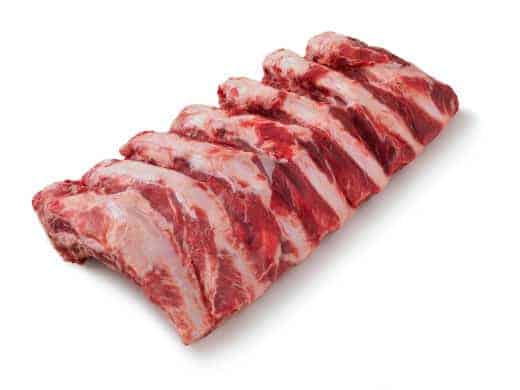
The Back ribs are the home of the Rib Eye steak and Prime Rib, so you know they're going to be tasty! These are the quintessential beef ribs loved by barbecue fans from far and wide.
Cost: Inexpensive to premium, depending on size and quality.
Best for: Low 'n' slow.
Chef's Tip: Back ribs are the perfect delivery vehicles for your favorite barbecue sauces.
Back Ribs Recipe to Try
- Barbecued Beef Back Ribs
Ribeye Cap Steak
Alternative names: Ribeye Cap; Spinalis dorsi
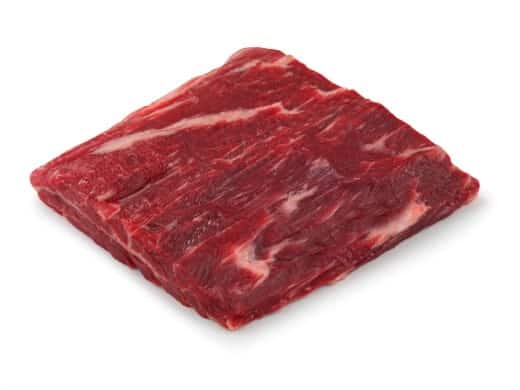
For some grillers, this is the ultimate steak, the Holy Grail of the grill. The butcher cuts it off the top of the ribs, and the single muscle could be up to 16" long, although it's never thick. It has a lot of beautiful marbling, so it cooks up tender and juicy with incredible flavor. They're somewhat rare because this muscle usually ends up incorporated into the Ribeye steaks.
Cost: Premium.
Best for: Direct grill and sear.
Chef's Tip: Don't waste this ultra-premium steak on your average backyard crowd; this is for meat-lovers only.
Ribeye Cap Steak Recipe
- Grilled Ribeye Cap w. Caramelized Onion Butter & Truffle Salt
Ribeye Petite Roast
Alternative names: Split Ribeye; Split Ribeye Roast
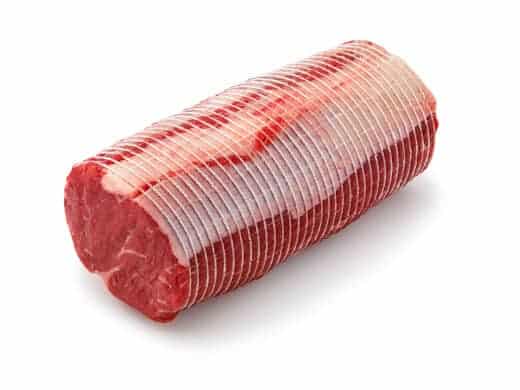
An attractive, lean, and flavorful roast beef, although a small one, as the name implies. These roasts typically come in around 1.5 – 2.5 lbs. As compensation, they have little peripheral fat, despite deep marbling, so there's not much in the way of wasted trimmings. Great on sandwiches, or for feeding a small group at dinnertime.
Cost: Moderate.
Best for: Indirect grill and roast, or direct grill and sear.
Chef's Tip: Versatile cut that lends itself to all kinds of seasonings, sauces, and rubs.
Ribeye Petite Roast Recipe
- Blackened beef ribeye roast surf and turf
Ribeye Filet
Alternative names: Ribeye Filet, Boneless
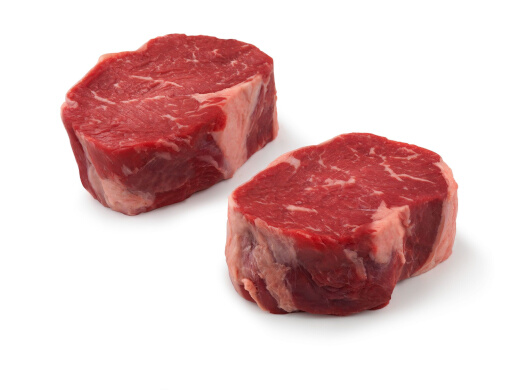
When the cap of the Ribeye steak is removed, the filet is what remains. The filet is a very rich and beefy cut, with plenty of marbling. It's a lean cut, and a very manageable size, usually between 4 – 8 oz.
Cost: Premium.
Best for: Direct grill and sear, or direct to indirect heat.
Chef's Tip: The flavor is rich enough to stand up to equally rich sauces and sides, such as béchamel, red wine sauces, shellfish, etc.
Ribeye Filet Recipe to Try
- Smoked Ribeye Filet with Butter Poached Lobster
Loin
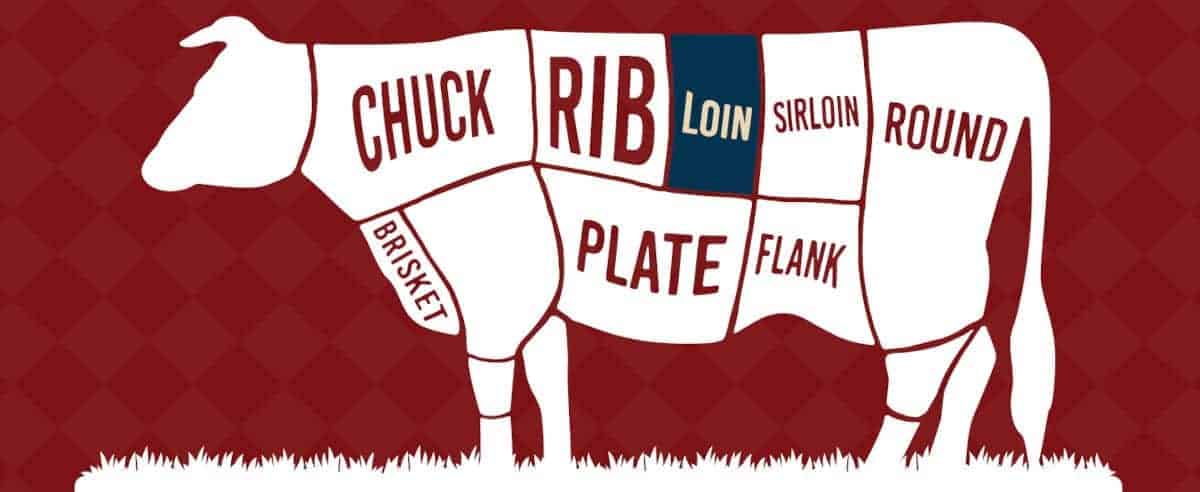
Sometimes called the 'Short Loin,' this section immediately follows the Rib section in the upper middle area of the beef.
Officially part of the hindquarters, and containing the 13th and final rib, some of the best-known steaks are cut from the Loin.
Meat from the Loin is usually tender and flavorful. The cuts from the Loin are all premium, are almost always lean and tend to be on the pricey side.
Porterhouse Steak
Alternative names: King Steak; Porter House; Porterhouse
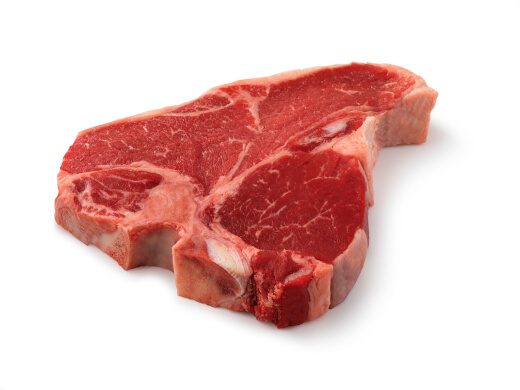
When I was young, to me this, along with whole lobster, was the pinnacle of sophisticated eating. Now that I'm older and wiser, I realize that I wasn't far off the mark back then! A Porterhouse is really just a "beefed up" T-bone: the USDA specifies the name "Porterhouse" may only be used to describe a T bone with a Tenderloin at least 1.25" wide. The large bone divides the Tenderloin steak from the Top Loin, or Strip steak. Yes, a Porterhouse is two steaks in one! No wonder they frequently exceed 20 oz.
Cost: Premium.
Best for: Direct grill and sear.
Chef's Tip: It's hard to mess this steak up — you'll get good flavor all the way through to medium-well. Sear on high heat to begin.
Porterhouse Steak Recipe to Try
- The Perfect Porterhouse Steak — Over The Fire Cooking
T-bone Steak
Alternative names: Loin, T-Bone Steak; T-Bone
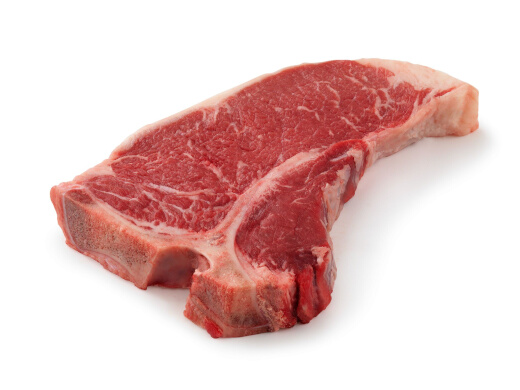
Like the Porterhouse, there are regulations that have to be met for this cut to be classified a T-bone. Specifically, the Tenderloin portion of the cut must be at least ½" wide. The T-bone is a highly popular steak in restaurants everywhere, and is a winner on the backyard BBQ, too.
Cost: Premium.
Best for: Direct grill and sear.
Chef's Tip: The two different steaks that make up a T-bone will cook at different rates. The Tenderloin cooks more quickly, so keep an eye on it to make sure it doesn't end up overdone.
T-bone Steak Recipe
- How to Grill the Best Porterhouse T-Bone Steak Recipe
Strip Steak, Bone-in or Boneless
Alternative names: Ambassador Steak; Beef Loin, Strip Loin Steak, Center-Cut; Club Steak; Country Club Steak; Delmonico Steak; Hotel Cut Steak; Kansas City Steak; Kansas City Strip Steak; New York Strip Steak; NY Strip Steak; Shell Steak; Strip Loin Steak; Top Loin Steak; Top Loin Steak
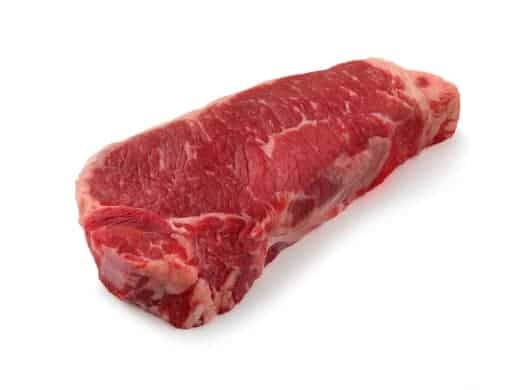
The Strip Steak is the steak of 1000 names, or at least a dozen. Going boneless makes serving a bit easier, and opens it up to thin slicing for sandwiches or other dishes.
One of the most sought-after steaks, and generally of exquisite tenderness and flavor. Strip steaks are usually about an inch thick and are surprisingly lean for an under worked muscle. Be warned, however: not all Strip steaks are created equal.
Strips cut from the backside of the loin may be tougher than those found to the front of the rib cage because of connective tissue.
Learn more in our detailed guide to strip steak.
Cost: Premium.
Best for: Direct grill and sear.
Chef's Tip: Choose a cut with a fine texture and plentiful flecks of fat to ensure a very juicy steak. Very flavorful, so skip the marinade and try a dry rub and maybe a dash of oil.
Strip Steak Recipe to Try
- How to cook the perfect New York strip steak — From HeyGrillHey.com
Strip Petite Roast
Alternative names: Top Loin Petite Roast
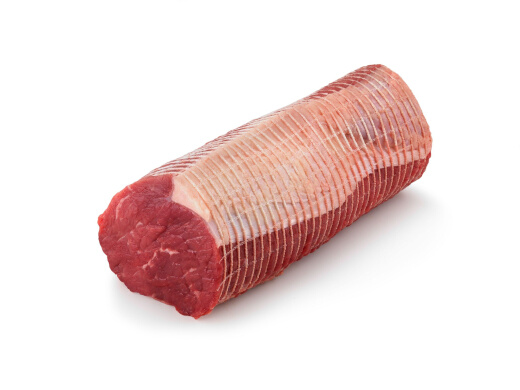
This cut is actually one half of a Top Loin cut lengthwise down the middle. They usually weight from 1.5 – 4 lbs., and have a top layer of fat that delivers a lot of flavor to the roast while it cooks. Despite the fat on top, this is still a lean cut.
Cost: Premium
Best for: Indirect grill and roast, or direct grill and sear.
Chef's Tip: Want a roast dinner for two at home? Thanks, to its manageable size and great flavor, this is the roast of choice for an intimate evening.
Strip Petite Roast Recipe
- Garlic-pepper top loin petite roast with roasted green beans & mushrooms
Strip Filet
Alternative names: Club Cut; Loin, Strip Steak, Split, Boneless; Strip (Loin) Filet; Strip Steak Filet; Strip Steak, Split; Top Loin Boneless Split; Top Loin Filet
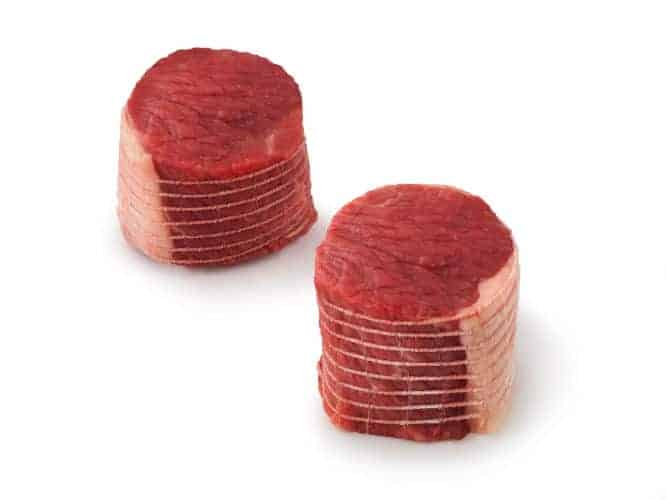
A small, thick, and (sort of ironically) lean filet cut from the Strip Loin. It's super juicy and bursts with flavor, but is usually only between 4 – 6 oz. Stays tender even when cooked to a high internal temperature. If you're looking for health benefits (and let's face it, that's the MAIN reason we all love beef…), this filet is big on iron and protein.
Cost: Premium.
Best for: Direct grill and sear, or direct to indirect heat.
Chef's Tip: A slightly less expensive alternative to a filet mignon, a Strip filet will impress your guests, and leave room on the plate for side dishes.
Strip Filet Recipe
- Chimichurri Steak Filets
Tenderloin Roast
Alternative names: Châteaubriand; Filet Mignon Roast; Full Tenderloin Roast; Tenderloin, Full, Side Muscle Off, Defatted; Tenderloin, Full, Side Muscle Off, Skinned; Tenderloin, Full, Side Muscle On, Defatted (PSMO)
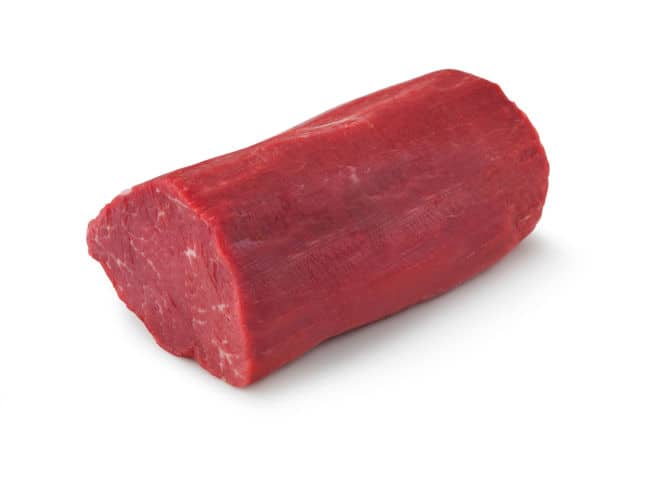
This cylindrical roast is cut from the short loin, and that's about as tender as it gets on a side of beef.
It's lean and mildly flavored, and will pretty much melt in your mouth, especially if cooked to just medium-rare.
Cost: Premium.
Best for: Indirect grill and roast, or direct grill and sear.
Chef's Tip: Tenderloin roast cooks quickly, so watch your heat and time on the grill.
Tenderloin Roast Recipe
- Roast beef tenderloin with garlic and rosemary
Tenderloin Filet
Alternative names: Beef Loin, Tenderloin Steak, Side Muscle Off, Skinned; Beef Tender Steak; Butt Tenderloin; Châteaubriand; Châteaubriand Filet De Boeuf; Filet De Boeuf; Filet Mignon; Filet Steak; Fillet de Boeuf; Fillet Steak; Medallions; Short Tenderloin; Tenderloin Medallion; Tenderloin Steak, Side Muscle Off, Skinned
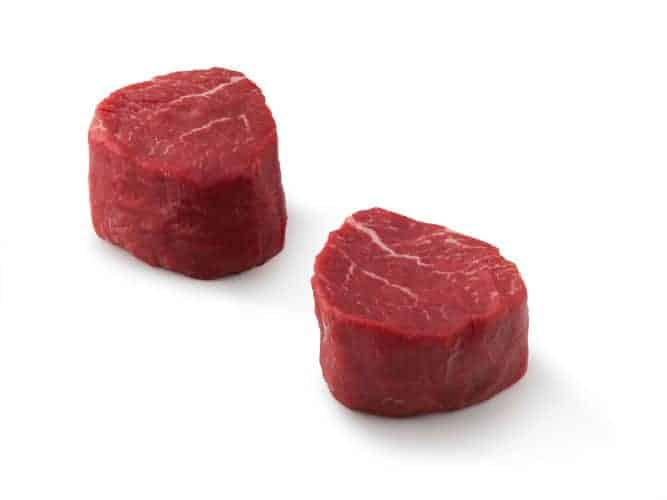
If you cut a Tenderloin across the narrow axis into little disc-shaped cuts, you're making Tenderloin filet. This delectable cut is frequently referred to as a Filet Mignon.
I see by the drool on the screen that you're familiar with this term? They are only 2 – 3" in diameter, and about an inch thick. Not big, but as desirable as they come.
You can learn a lot more about this most tender of cuts in our tenderloin steak guide.
Cost: Premium.
Best for: Direct grill and sear, or direct to indirect heat.
Chef's Tip: Cook very hot, very quickly, and do not go beyond rare, otherwise it will dry out. Also, although very, very tender, the flavor is somewhat mild. Wrap it in bacon, or give it a good rub to make it pop.
Tenderloin Filet Recipe
- Grilled filet mignon
Sirloin
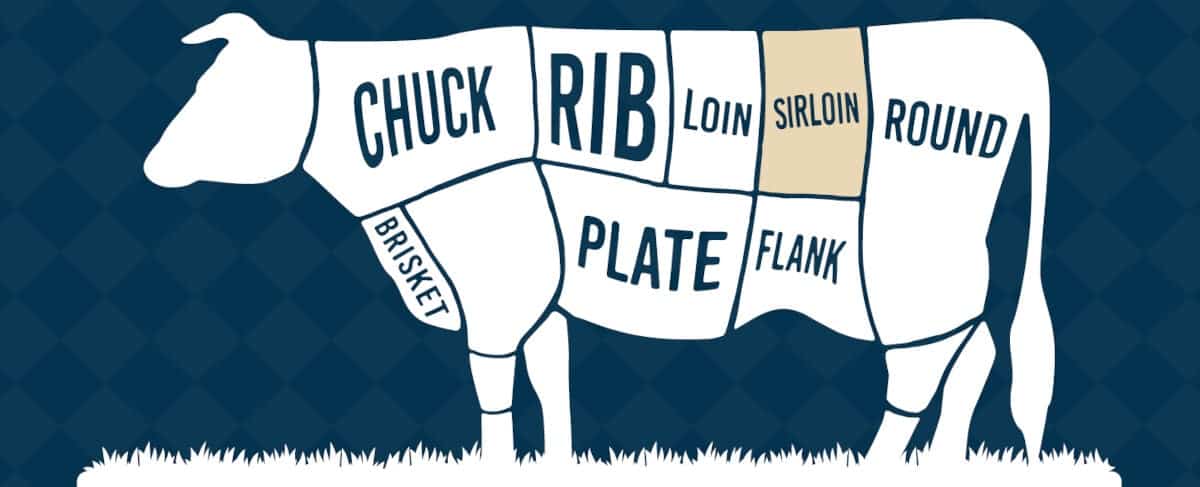
The second last section toward the back of the beef.
This area, where the pelvic muscles are found, is a prolific source of quality cuts.
Although the meat here is generally less costly than that in the Loin, it certainly doesn't mean it's less tasty. Very good steaks are found here, many of which are commonly found on steakhouse menus.
Like the Loin cuts, most Sirloin meat is best when cooked in a direct grill/sear fashion, although there are some nice cuts for indirect grilling/roasting.
Top Sirloin Steak
Alternative names: Boneless Sirloin Butt Steak; Boneless Top Sirloin Steak ; Loin, Top Sirloin Butt Steak, Boneless; Sirloin Butt Steak; Top Sirloin Butt Center-Cut Steak; Top Sirloin Butt Steak, Boneless; Top Sirloin Steak Boneless Cap Off; Top Sirloin Steak Cap Off
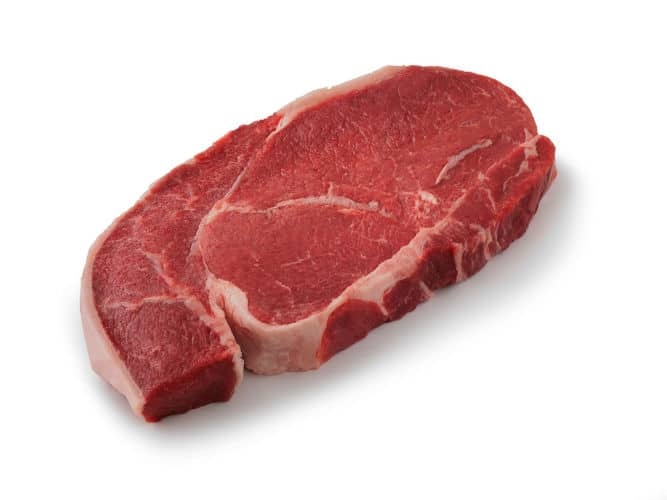
Similar to a Sirloin, except the bone and several surrounding muscles are removed.
In 19th century cooking, this was sometimes called a Châteaubriand, but the French disagree with that usage of the term and now use it to describe a thick cut from the tenderloin filet instead.
It's a reasonably tender steak, though not as tender as cuts from the Loin. However, it makes up for this with a richer flavor, owing in part to the extra fat. (Though it is still considered a lean cut.)
Learn more in our sirloin steak guide.
Cost: Premium.
Best for: Direct grill and sear, or cooking with a Wok on the grill.
Chef's Tip: Choose a cut at least 1" thick to avoid drying out at high heat.
Top Sirloin Recipe
- How to Grill Top Sirloin the Right Way
Top Sirloin Petite Roast
Alternative names: Top Sirloin Petite Roast, Boneless
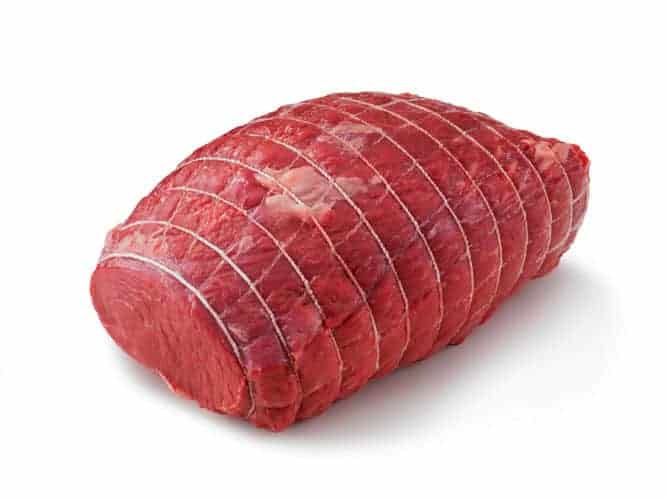
A small roast cut from the Top Sirloin, lean and tender. There's a lot of flavor in this small roast, so you won't need to do much to it aside from cook it the way you like it.
It comes in many sizes, but 2.5 – 4 lbs. Is about average.
Cost: Moderate.
Best for: Indirect grill and roast, or direct grill and sear.
Chef's Tip: Carves easily into filets or sandwich slices.
Top Sirloin Petite Roast Recipe
- Top Sirloin Petite Roast with Parmesan Roasted Tomatoes
Top Sirloin Filet
Alternative names: Baseball Cut; Center-Cut Top Sirloin Steak; Top Sirloin Butt Steak; Top Sirloin Butt Steak, Center-Cut; Top Sirloin Butt Steak, Center-Cut, Boneless; Top Sirloin Filet Boneless; Top Sirloin Steak
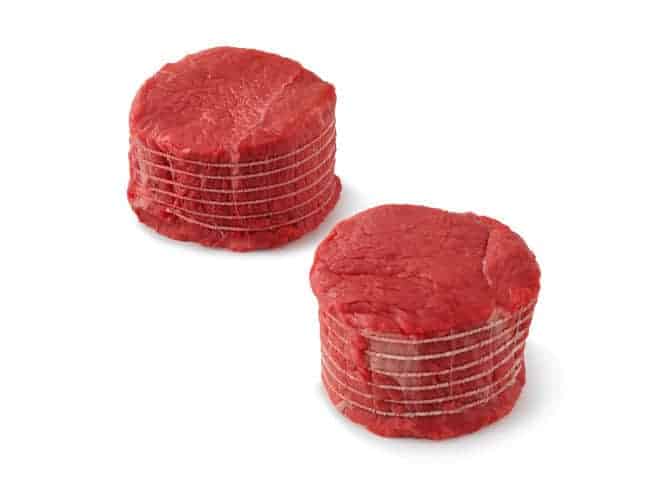
This is a medium-size medallion of meat cut from the Top Sirloin, in somewhat the same manner as a Tenderloin Filet.
It looks just like a Filet Mignon, but it costs less.
It's a lean and moist cut, usually 4 – 8 oz. Thick cuts are sometimes sold as "Baseball Steaks," and they are just about spherical.
Cost: Moderate.
Best for: Direct grill and sear, or direct to indirect heat.
Chef's Tip: Give it a good rub and sear for a tasty crust, but don't overcook the inside. You could cook this steak until well-done, but it's a lot easier — and tastier — to leave it pink inside because of the thickness of the cut, and it's tenderness.
Top Sirloin Filet Recipe
- Grilled Top Sirloin Filets with Italian Salsa Verde
Coulotte Roast
Alternative names: Beef Loin Top Sirloin Cap, Coulotte, Boneless; Beef Loin, Top Sirloin Cap Roast, Boneless; Beef Loin, Top Sirloin Cap Steak, Boneless; Sirloin Cap; Top Sirloin Cap Steak; Top Sirloin Cap, Boneless; Top Sirloin Cap, Coulotte, Boneless
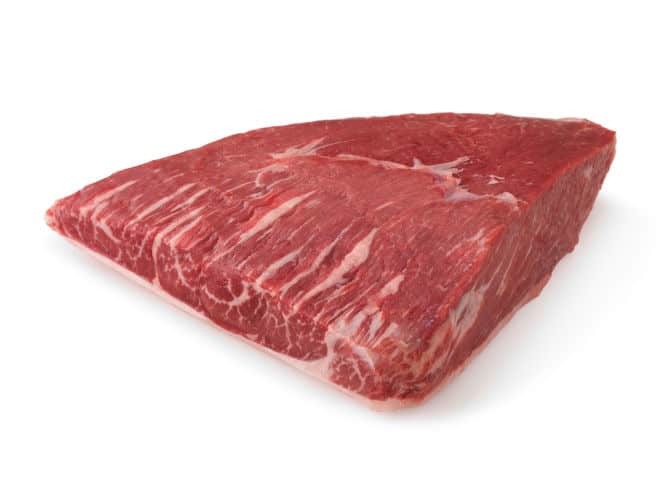
A smallish roast formed by removing the Top Sirloin Cap. It's nice and flavorful, juicy, and tender, at least for a Top Sirloin cut.
Cost: Premium.
Best for: Indirect grill and roast, or direct grill and sear.
Chef's Tip: Commonly found in Brazilian-style steakhouses; excellent for South or Latin American dishes.
Coulotte Roast Recipe
- Smoked beef coulotte roast
Tri-Tip Roast
Alternative names: Bottom Sirloin Roast; Tri-Tip; Triangle Roast
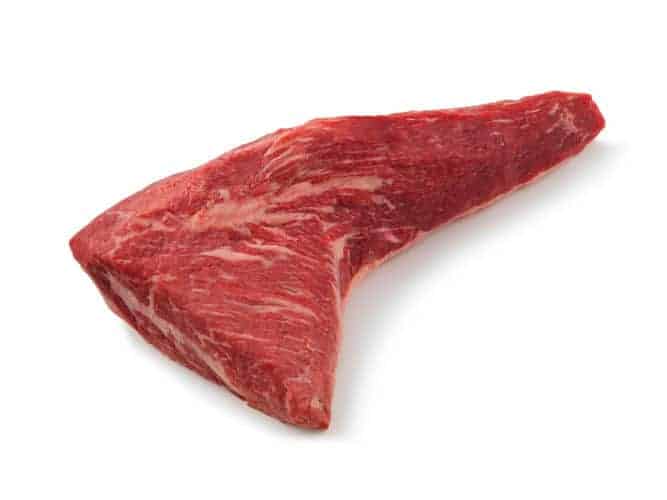
Sometimes known as a "Triangle Roast," there's only one of these per side, and it's usually between 1.5 – 2.5 lbs. Until the 1950s, it was almost invariably ground in hamburger meat.
Rich with flavor, and rather tender, this is a small roast worth a try, if you can find one.
Click here for more on the tri-tip roast.
Cost: Inexpensive to Moderate.
Best for: Indirect grill and roast, or direct grill and sear.
Chef's Tip: Can turn rubbery if over-cooked due to a lack of fat.
Tri-Tip Roast Recipe
- Grilled Santa Maria-Style Tri-Tip
Tri-Tip Steak
Alternative names: Santa Maria Steak; Tri-Tip; Tri-Tip; Triangle Steak
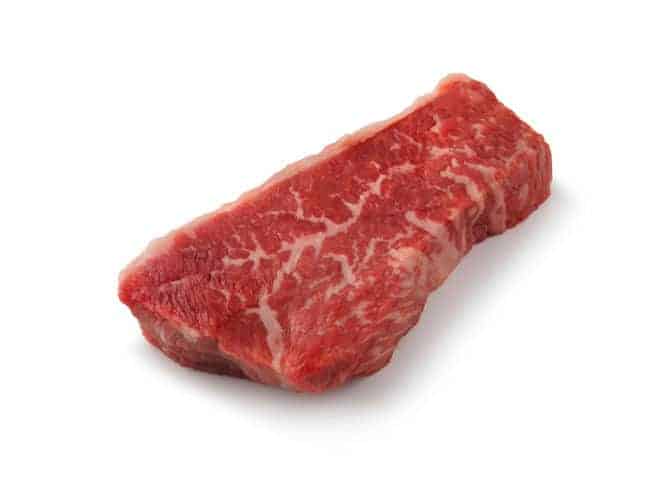
A small steak cut from its namesake roast, usually an inch thick, or so.
It's tasty and relatively inexpensive, but not a tremendously tender cut.
Might be difficult to find in a typical grocery store, so you might have to ask your butcher to cut one off for you.
Cost: Inexpensive to Moderate.
Best for: Direct grill and sear, or cooking with a Wok on the grill.
Chef's Tip: Well suited to an Asian or Southwestern marinade.
Tri-Tip Steak Recipe
- Tri-Tip with Chimichurri
Petite Sirloin Steak
Alternative names: Ball Tip Steak; Loin Ball Tip Steak, Boneless
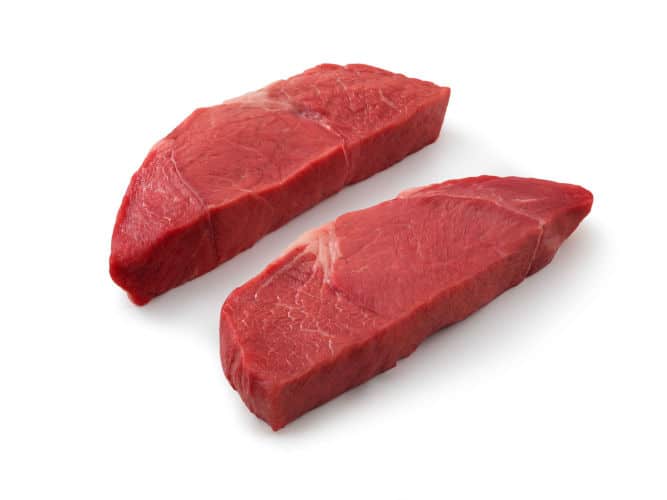
The Petite Sirloin is a lesser-known steak found near the rump.
Rumps get worked pretty hard from all the walking, so this is not a tender steak, though it is flavorful.
Portion size leans toward the small side, usually 6 oz. Or less.
Cost: Inexpensive.
Best for: Direct grill and sear.
Chef's Tip: Because it's not so tender in its natural state, this is a good steak for an overnight marinade.
Petite Sirloin Steak Recipe
- Grilled Petite Sirloin Steak Recipe — Mr. B Cooks
Bavette (Sirloin Bavette)
Alternative names: Bottom Sirloin Butt, Flap, Boneless; Bottom Sirloin Flap; Bottom Sirloin Flap Bavette; Flap Meat
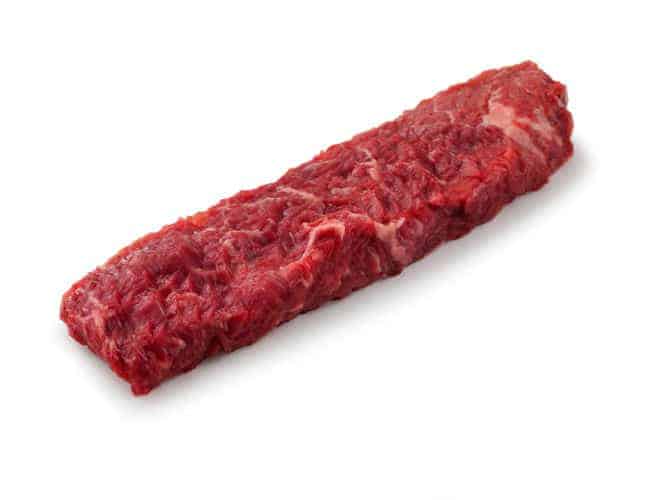
A thin-cut steak sometimes called the Sirloin Flap. The Bavette is finding new popularity thanks to its versatility and low cost.
It's boneless, and has no connective tissue, making it very easy to cut up into strips for fajitas or cubes for stir-fry.
Click here for more details, in our bavette steak guide.
Cost: Inexpensive.
Best for: Direct grill and sear, or cooking with a Wok on the grill.
Chef's Tip: Cook on high heat, but keep it medium-rare, or else it becomes too tough.
Sirloin Bavette Recipe
- Nigel Slater's grilled bavette recipe
Round
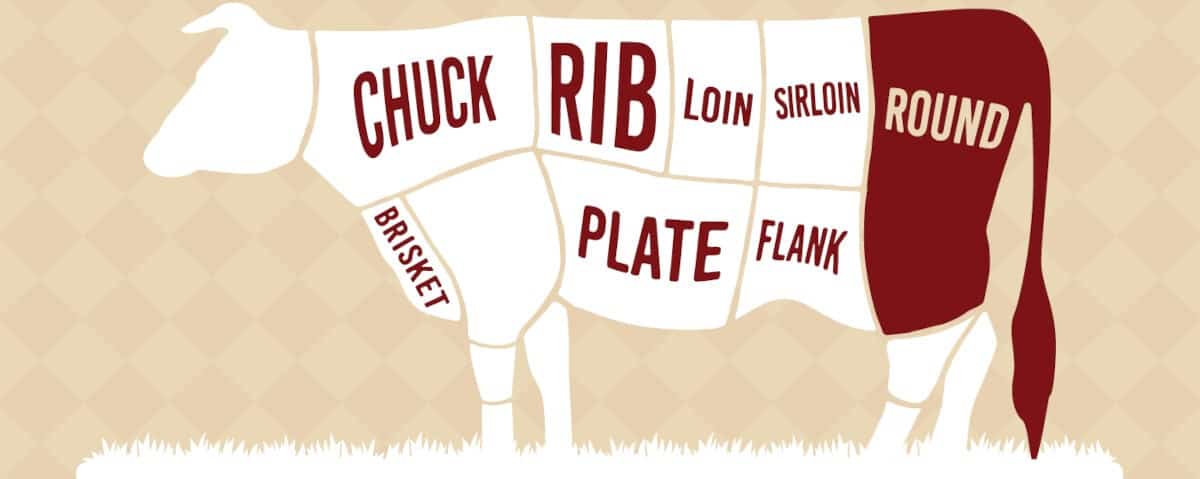
The Round cuts are found at the very most hindquarter of the beef. Everything found here is nice and lean, and usually not too expensive, with a couple of exceptions.
None of the cuts are as tender as their Sirloin neighbors, however, and many may benefit from a marinade.
Round cuts are suitable for direct grill/sear, or for a wok on the grill, though you might also consider going with a Dutch oven to keep it as juicy as possible.
Top Round Steak
Alternative names: Beef Round, Top (Inside) Round Steak; London Broil; Short Cut; Top (Inside) Round Steak; Top Round London Broil; Top Round Steak (Center Cut); Top Round Steak Boneless
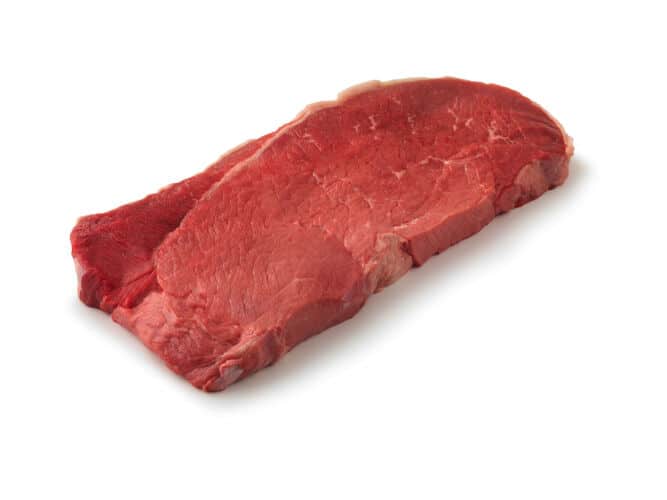
A lean steak, usually sold in thin cuts ¾" thick or less. There's not much marbling to be found here, but it's still reasonably tender. As with all lean cuts, be super careful not to over-cook a Top Round.
Cost: Moderate.
Best for: Direct grill and sear, or cooking with a Wok on the grill.
Chef's Tip: If you have a smoker, this is a recommended cut for making your own jerky.
Top Round Steak Recipe
- Tangy Lime Grilled Top Round Steak
Click here for all you need to know about this cut in our deeper look at the top round steak.
Bottom Round Roast
Alternative names: Bottom Round Oven Roast; Bottom Round Pot Roast; Bottom Round Rump Roast; Round Roast
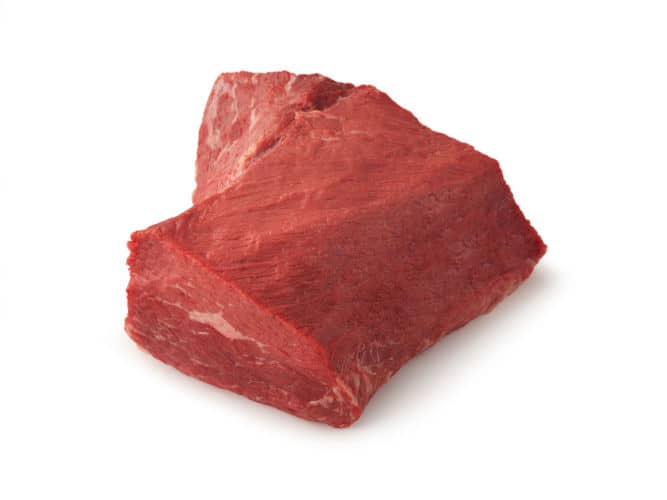
This cut from near the hip is low-cost, low-fat, but also low-flavor.
Don't let that deter you, however, because you can always add your own flavor and come up with a delicious dish, including serving it pulled with sauce.
Cost: Inexpensive.
Best for: Low 'n' slow, or indirect grill and roast.
Chef's Tip: Serve the finished product sliced thin to keep chewing from being a chore.
Bottom Round Roast Recipe
- Smoked Bottom Round Roast Recipe — Grill Master University
Click here for a deeper look at this cut, in our guide to the bottom round roast.
Western Steak / Bottom Round Steak
Alternative names: Western Griller
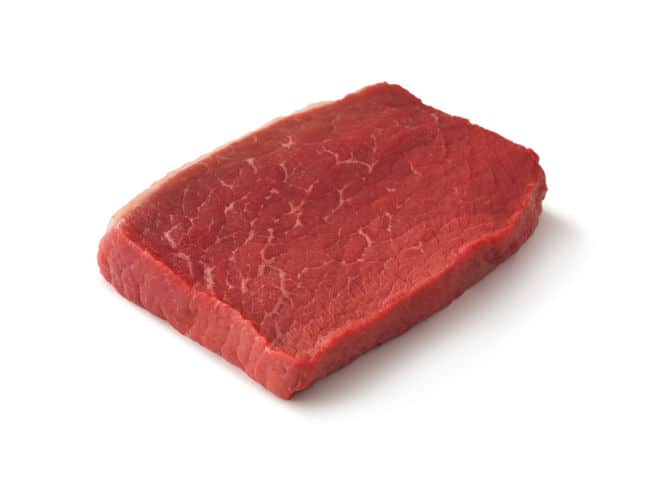
Like the Bottom Round roast, this steak is cut from the lower portion of the round, a section of the back leg. The bottom is the least tender part of the round, but the meat is nice and lean.
Sometimes sold with a cross-section of femur embedded in the meat, from which the name "round" is derived.
Cost: Inexpensive.
Best for: Direct grill and sear.
Chef's Tip: Wet cooking methods work, but you can grill this steak to a medium rare with good results, especially if you tenderize it first.
Western Steak Recipe
- Barbecue Round Steak — Deep South Dish
Eye of Round Roast
Alternative names: Round Eye Pot Roast
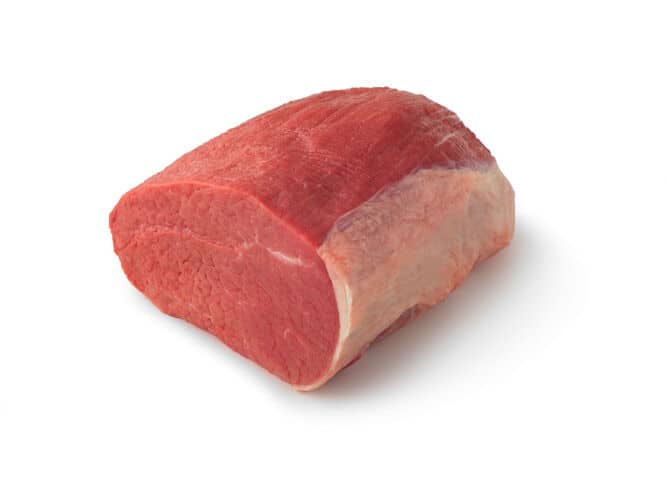
A lean roast, but with fat on one side, and it's fairly tender compared to other cuts from the Round.
Eye of Round has been popular for Sunday roasts for a very long time. You can learn more about it in our guide to the eye of round roast.
Cost: Inexpensive to Moderate.
Best for: Indirect grill and roast.
Chef's Tip: Cook medium rare and slice against the grain to maximize tenderness.
Eye of Round Roast Recipe
- Barbecued Eye of Round with a Pepper Crust — Thrifty Foods
Eye of Round Steak
Alternative names: Beef Round Eye Round Steak
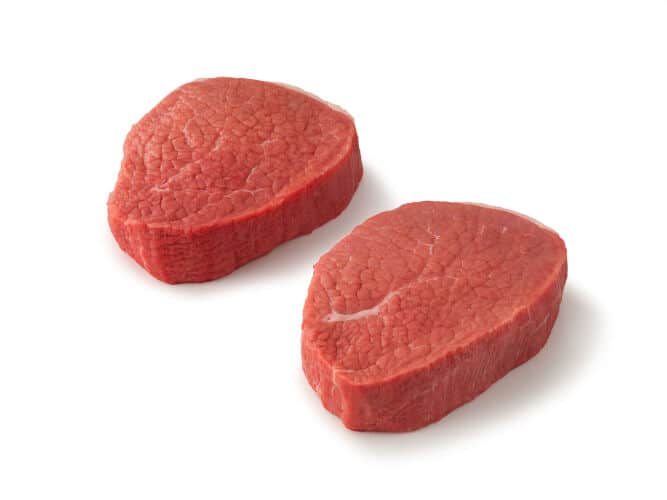
These steaks are cut from the roast of the same name but are missing the layer of fat. Because the fat is missing, they are more likely to come out dry and chewy, so care must be taken to cook minimally.
The bonus is you can cook a small Eye of Round fairly quickly.
Cost: Inexpensive to Moderate.
Best for: Direct grill and sear, or cooking with a Wok on the grill.
Chef's Tip: Good choice for adding to stew or stir-fry. The extra moisture will greatly benefit this cost-effective cut.
Eye of Round Steak Recipe
- Spiced Lime-Marinated Eye of Round Steaks Recipe
Brisket
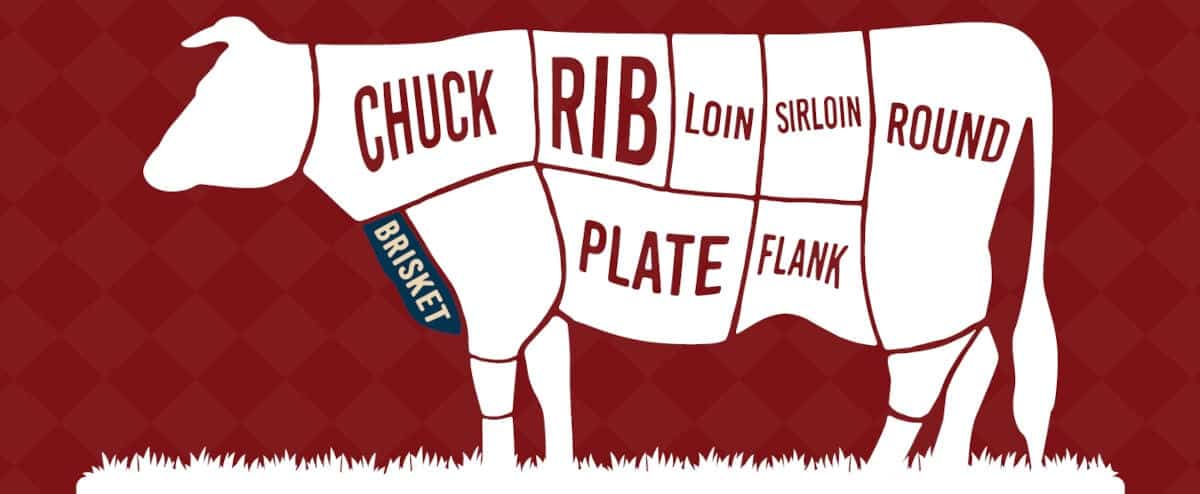
Coming back to the front of the cow, we find the beef Brisket in the breast section, below the first five ribs.
The butcher will often cut this out boneless, and a large animal can yield a whole packer cut brisket weighing up to 20 lbs.
The chest area is a hard-working part of the cow, and so this muscle is very tough! But it's also quite marbled and a joy to eat when cooked low n slow.
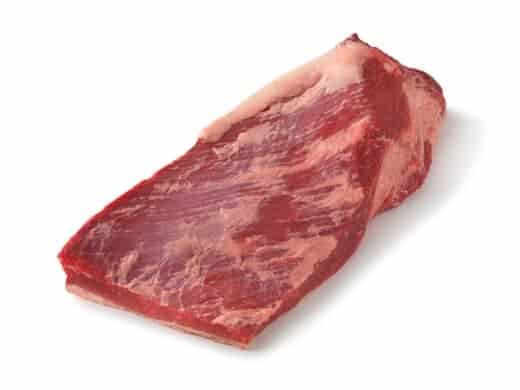
This versatile cut gives us corned beef and pastrami, bless its soul.
Although it can be tough (thanks to supporting 60% of the weight of the animal), done low 'n' slow, some wonderful things can be achieved fairly economically.
Brisket Flat
Alternative names: Beef Brisket Middle Cut, Boneless; Boneless Brisket; Brisket Center-Cut; Brisket First Cut; Brisket Flat Cut; Brisket Front Cut; Brisket Middle Cut; Brisket Nose Cut; Fresh Beef Brisket
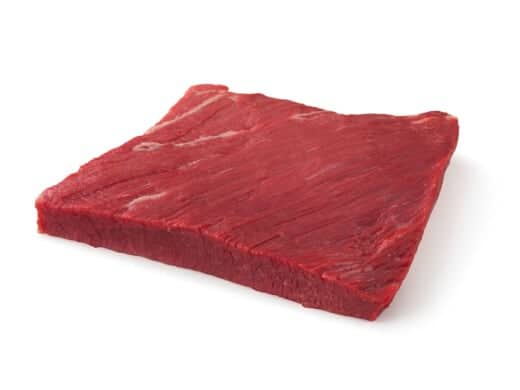
The flat is the larger and lower of the two Brisket sections, separated from the Point by a layer of fat.
It's fibrous and not as inherently fatty as its brisket brother, so if you can get it with the layer of fat intact, so much the better.
Briskets come cut to different sizes but can be extremely large. Before you buy a 20-pound brisket, be sure you have somewhere to cook that monster!
Cost: Inexpensive to Moderate.
Best for: Low 'n' slow.
Chef's Tip: Cook to in excess of 203 °F until it is super tender and all connective tissue has rendered, then slice across the grain to max out on tenderness.
Brisket Flat Recipe
- BBQ Beef Brisket Recipe And Techniques, Smoked Texas Style
Brisket Point
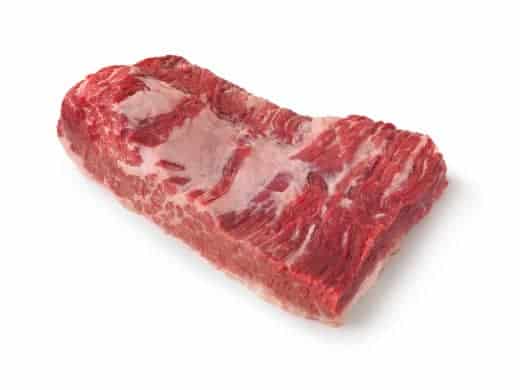
The thicker, fattier, and moister of the beef brisket cuts, it's also the more economical of the two.
It's a popular choice for deli meat, so it may be harder to come by than the Flat. Although it's the less expensive half of the brisket, it's also more flavorful.
Cost: Inexpensive.
Best for: Low 'n' slow.
Chef's Tip: Take to 203 F or more until super tender, then cut across the grain for maximum tenderness.
Brisket Point Recipe
- How to make Best-ever BBQ Brisket Burnt Ends — Jess Pryles
Plate & Flank
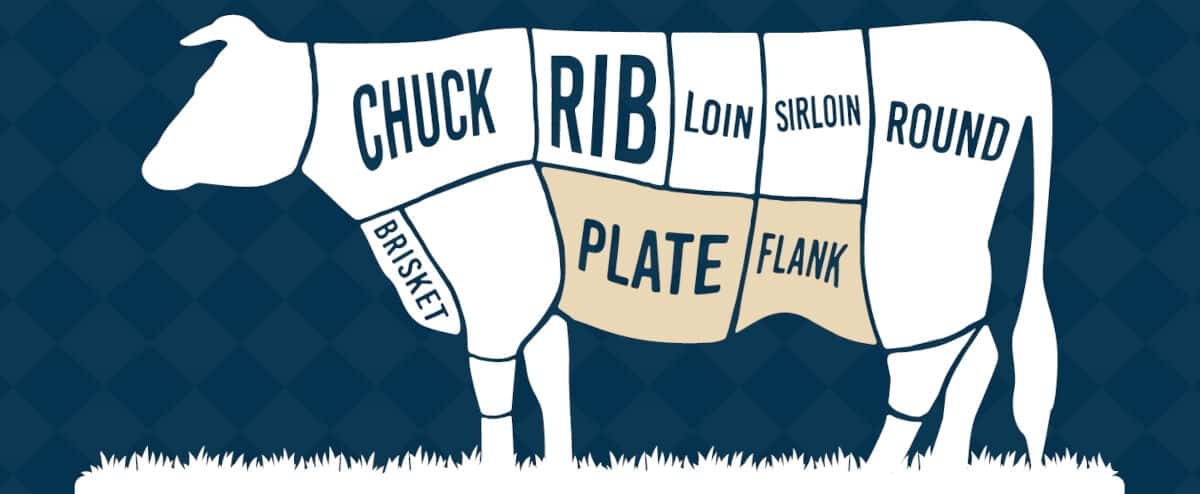
Together, the Plate & Flank make up the entire underbelly of the beef. Surprisingly, there are only a few cuts to be found in these sections.
The meat here is moderate to expensive, and suitable for low and slow or wok on grill cooking.
Since this area contains the abdominal and diaphragm muscles, the meat here can be lean and tough from being worked so hard.
Inside Skirt Steak
Alternative names: Beef Plate; Boneless Diaphragm; Fajita Meat; Fajita Steak; Inside Skirt Steak; Outside Skirt Steak; Philadelphia; Skirt Steak
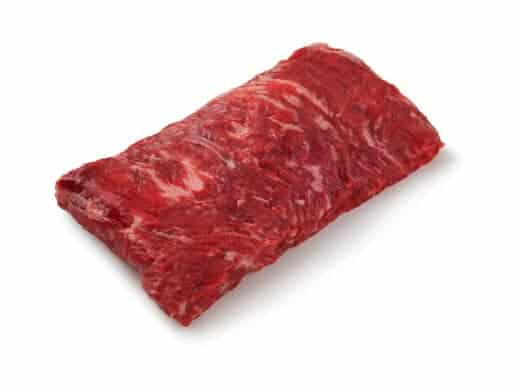
The Skirt steak is a long and thin cut from the diaphragm. It's lean but has tough fibers to contend with.
The flavor is rich and truly beefy, so it may not need much help in the way of seasonings or marinade, though it is traditionally marinated and grilled hot for fajitas.
Cost: Moderate.
Best for: Direct grill and sear, or cooking with a Wok on the grill.
Chef's Tip: Although it's a tasty steak, it's a bit tough, so it's good to cut it down into strips for serving — fajitas, anyone?
Inside Skirt Steak Recipe
- Grilled Skirt Steak With Garlic and Herbs Recipe
Outside Skirt Steak
Alternative names: Beef Plate Skirt Steak Boneless; Diaphragm; Fajita Meat; Fajita Steak; Inside Skirt Steak; Outside Skirt Steak; Philadelphia Steak
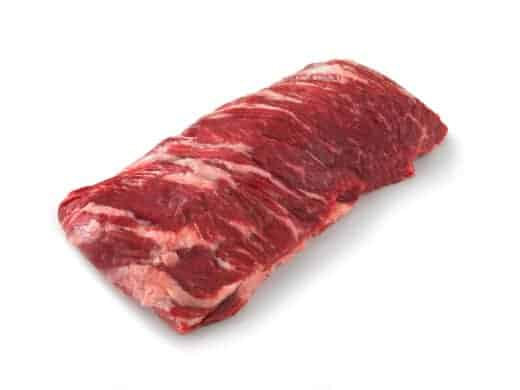
Taken from opposite the inside skirt, the outside skirt has similarly robust flavor profile to the inside skirt. Typically marinated, then sliced thin against the grain for use in stir fries, or grilled hot and fast and sliced thin for fajitas.
Cost: Moderate.
Best for: Direct grill and sear, or cooking with a Wok on the grill.
Chef's Tip: Make sure to sear over very high heat, and rest for a good 10 minutes at least. Cooking slower will make it tough, not resting will leak a ton of juices.
Outside Skirt Steak Recipe
- Perfect Grilled Skirt Steak Recipe — Food Republic
Hanger Steak
Alternative names: Hanging Tender
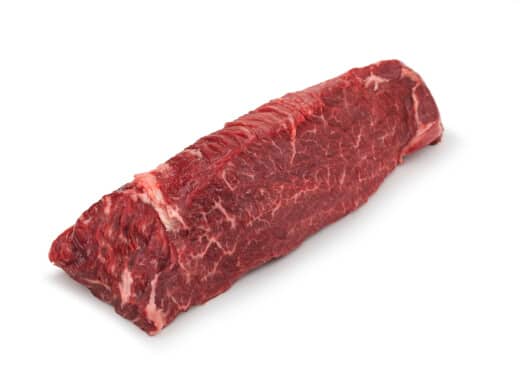
The hanger steak, taken from the plate section of the animal, is taken from the diaphragm of a steer or heifer. Its name is derived from the fact it literally just 'hangs' there, doing nothing.
Because it does no work in the animal, it is incredibly tender. There's only one per animal and is just about 1 to 1.5 pound in weight.
Also, as it's so tender and flavorful, it's earned the name 'butchers steak,' because the butcher would try to hold this back for their own consumption.
Cost: Moderate.
Best for: Direct grill and sear, or cooking with a Wok on the grill.
Chef's Tip: Best cooked to medium rare or medium maximum, to preserve the inherent tenderness of the meat. Also, MUST be sliced against the grain for serving, as it has a thread-like, grainy texture and falsely seems 'chewy' if cut with the grain.
Hanger Steak Recipe
- Grilled Hanger Steak, With Flambadou Bone Marrow and ChimiChurri — FoodFireFriends.com
Flank Steak
Alternative names: Beef Flank; Flank Steak Filet; Jiffy Steak; London Broil; Plank Steak
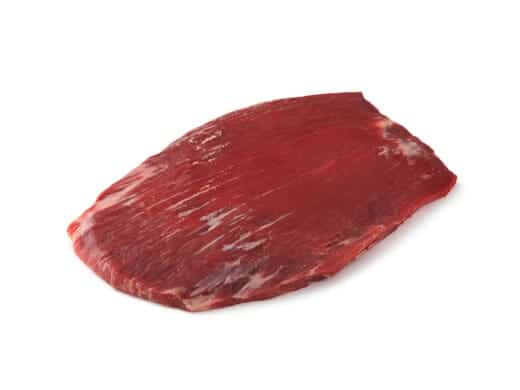
Alternative names: Beef Flank; Flank Steak Filet; Jiffy Steak; London Broil; Plank Steak
The Flank is closer to the rear of the beef than the Skirt, and it, too, is fairly tough since it's an active muscle zone. It is lean like a Skirt, but it's wider too.
Lots of flavor here, but might be good to marinate to keep it moist.
For a more in depth look at this cut, please check our flank steak guide.
Cost: Premium.
Best for: Direct grill and sear, or cooking with a Wok on the grill.
Chef's Tip: As with other tough cuts, cut against the grain to release the stringy fibers and cook quickly. This can be a delicious steak, but it can also go terribly wrong if you're not attentive.
Flank Steak Recipe
- The Best Marinated and Grilled Flank Steak | Hey Grill, Hey
Plate Short Ribs, Bone-In
Alternative names: Flanken Style Ribs
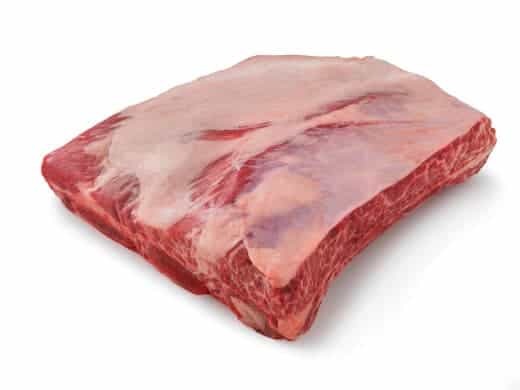
Short ribs may be cut from many sections of the rib cage across several primal zones.
Ribs from the Plate (short plate ribs) are usually the least expensive. They can be purchased cut across the bones with many short sections of rib connected by the meat, but are usually sold as individual pieces of rib bone with meat attached.
Cost: Inexpensive.
Best for: Low and slow.
Chef's Tip: These ribs make great little finger foods and lend themselves to Asian recipes, especially Korean ribs.
Short Rib Recipe
- Smoked Beef Ribs from FoodFireFriends.com
Other
Although 'Other' isn't a specific part of the beef you'll find on the carcass or on our map of cuts, these are commonly found cuts in grocery stores and at the butcher shop.
Some of the cuts are made from other cuts that are in lower demand than the more popular steaks, ribs, and roasts.
Most are added to or become other dishes, such as stews, fajitas, casseroles, and burgers. Good bang for your beef buck, usually!
Kabobs
Alternative names: Beef Cubes for Kabobs; Diced Beef; Shish Kebob
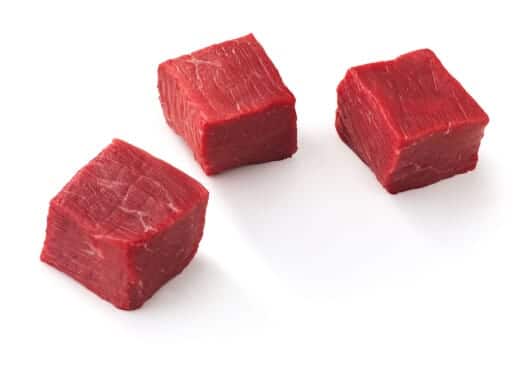
Shish Kabobs are very popular on the grill, and so colorful and tasty, they appeal to almost everyone.
Any cut of beef can be cut into cubes for Kabobs, but you'll want to pick a cut that suits the doneness level you want.
Tenderloin is a fantastic choice for rare to medium rare, but you might want to try Top Sirloin for medium Kabobs.
Cost: Inexpensive to Moderate.
Best for: Direct grill and sear.
Chef's Tip: Cook only bite-size cubes for convenience and even doneness.
Kabobs Recipe
- Steak Kebabs — A Flavorful Steak Recipe! — Cooking Classy
Strips
Alternative names: Beef for Stir-Fry or Fajitas; Fajita Meat; Fajitas; Stir Fry
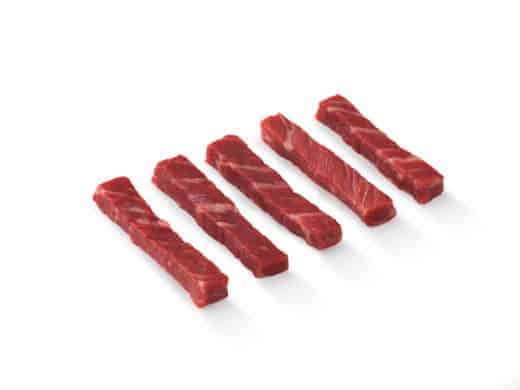
These are pre-cut strips of beef made from just about any part of the beef. They're time savers for anyone making fajitas, or stir-fries.
Depending on the size, they may not be easy to cook on a grill. Thanks, to their small size, they'll be cooked through in minutes.
Cost: Inexpensive.
Best for: Direct grill and sear, or cooking with a Wok on the grill.
Chef's Tip: If the strips aren't from high-grade cuts, consider a marinade, and do not over-cook.
Sliced Strips of Steak Recipe
- Asian BBQ Beef Strips — The Midnight Baker
Cubed Steak
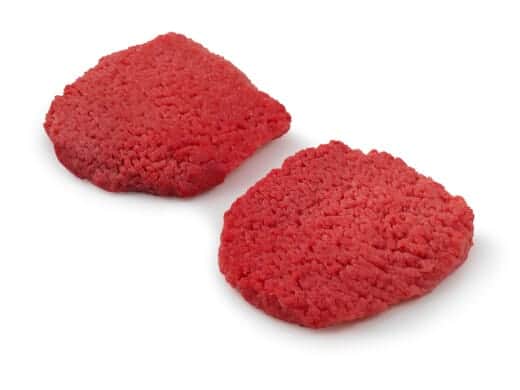
Not a specific cut, but a preparation style. The butcher will take tougher steak, likely from the Round or the Chuck, and run it through a mechanical tenderizer that pounds cube-shaped marks into the meat.
It's an effective way of making a tough steak more palatable, and they are commonly used for Chicken Fried Steak (a favorite of mine when I'm in the U.S.), and Swiss Steak.
Cost: Inexpensive.
Best for: Direct grill and sear, or low 'n' slow.
Chef's Tip: You can cube your own steak by beating it with a meat tenderizing mallet, but don't waste your effort on a good-quality cut.
Cubed Steak Recipe
- Grilled Cube Steaks and Peppers with Potato Planks
Stew Meat
Alternative names: Diced Beef; Stew Beef
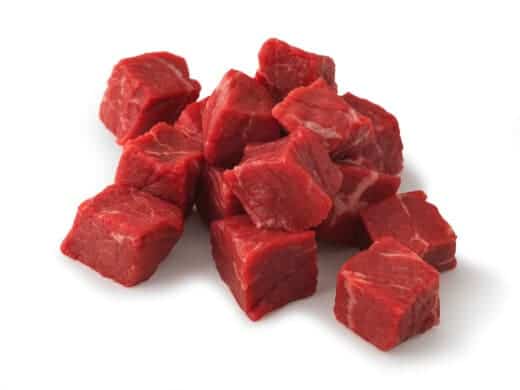
Stew meat looks a lot like Kabob meat, but the cut is usually from a tougher section of the beef.
Meat with good marbling doesn't do well when cooked slowly in a stew because the fat just disappears into the liquid, leaving the meat tough and chewy.
Lean, naturally tough meat, however, will soften up and relax, and the connective tissue will melt into the meat, adding great texture.
Cost: Inexpensive.
Best for: Low 'n' slow.
Chef's Tip: Sear your stew meat over high heat, and let it finish cooking in the stew for the best flavor.
Stewed Beef Recipe
- Barbecue spiced beef stew with cheesy scone topping
Shank Cross Cut
Alternative names: Center Beef Shanks; Cross-Cut Shanks; Fore Shank for Soup
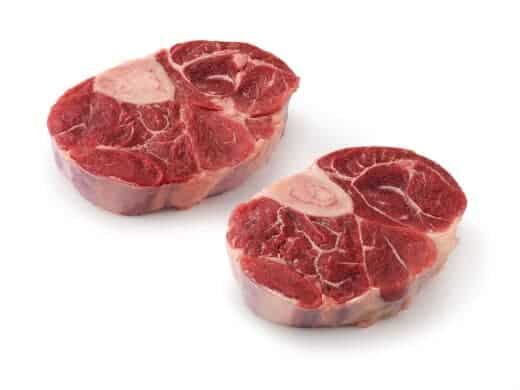
On some charts, the Shank is considered a Primal cut, or at least a Sub-primal, zone. It's a lean cut found at the top of the legs. Shanks include a cross-section of the bone and have nice marbling. They're actually rather tough, but will cook up nice and tender if you have the patience.
Cost: Inexpensive.
Best for: Low 'n' slow.
Chef's Tip: The gourmet dishes beef bourguignon and Osso Bucco can each be made from Shank.
Shank Cross Cut Recipe
- Braised Beef Shank with Wine and Tarragon
Ground Beef and Ground Beef Patties
Alternative names: Ground Chuck; Ground Round; Ground Sirloin; Ground Steak
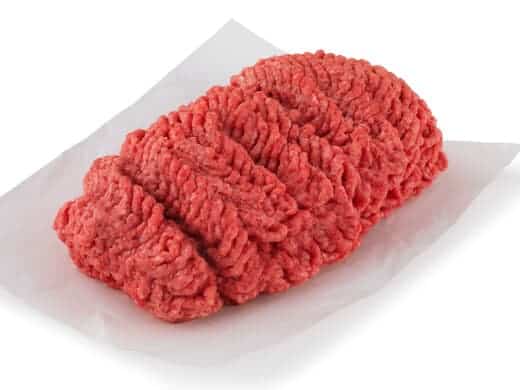
Ground beef can come from almost anywhere on the cow but tends to come from less popular sections for roasts and steaks, such as the Chuck. (Hence, the commonly found "Ground Chuck.") Although ground beef has many uses, BBQ fans almost always use it pressed into patties. Nothing says backyard summer barbecue like a thick and juicy hamburger.
Cost: Inexpensive.
Best for: Direct grill and sear.
Chef's Tip: Expensive Ground beef is not always better! Fat content is more important — aim for about 18% fat for a juicy burger.
Ground Beef Recipe
- BBQ Beef Sloppy Joes
Outdoor Cooking Techniques
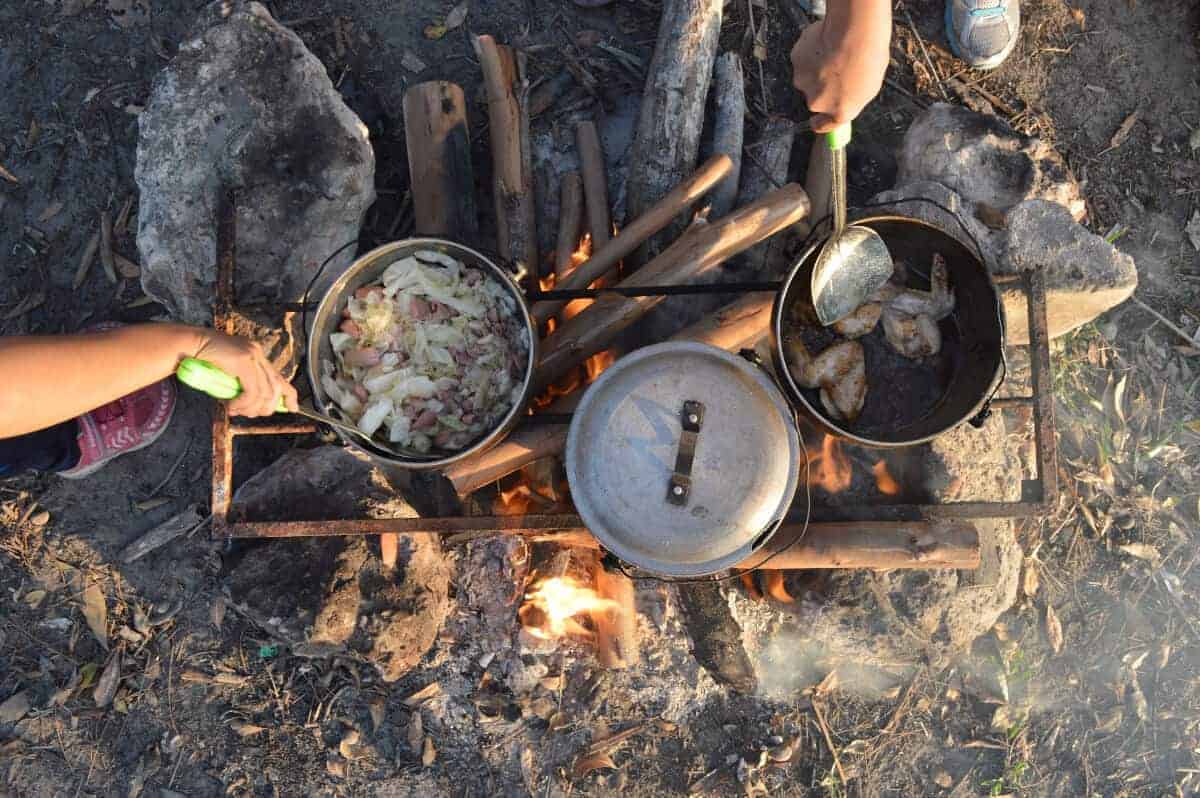
Now we've covered all the different cuts of beef, let's take a moment to go over the primary methods of cooking them outdoors.
There are six basic kinds of cooking a backyard chef should know of. These are:
- Direct grilling/searing
- Low 'n' slow (smoking wood preferred, but optional)
- Indirect grilling/roasting
- Dutch oven on the grill
- Wok on the grill
- Texas Crutch
Here's a quick overview of each. These should whet your appetite, and if you want to know more, I promise we'll cover each in detail elsewhere.
Direct Grilling/Searing
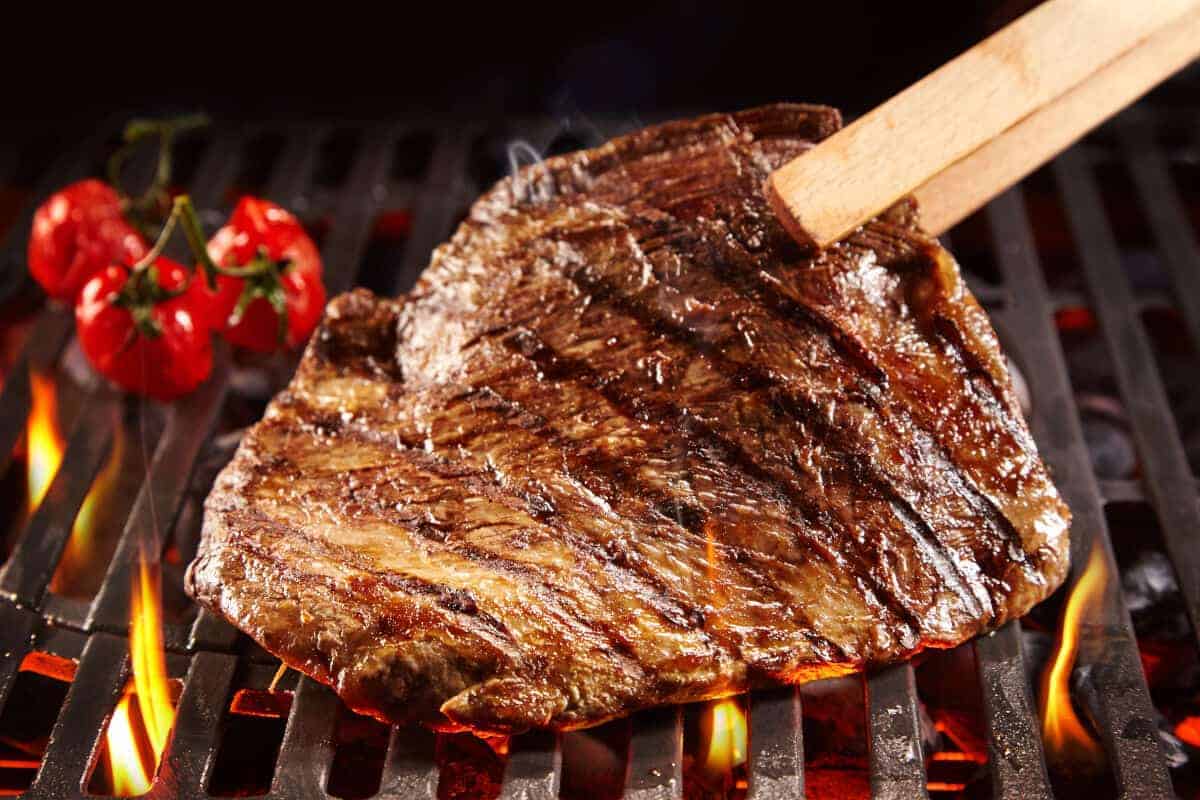
Using high heat to cook thin cuts of meat in a hurry. Steaks, veg, chicken, chops, and more (when thinly cut) all benefit from this technique.
Searing gives those delicious-looking grill marks we all strive for and creates a flavor-packed outer crust.
Low 'n' Slow and Smoking
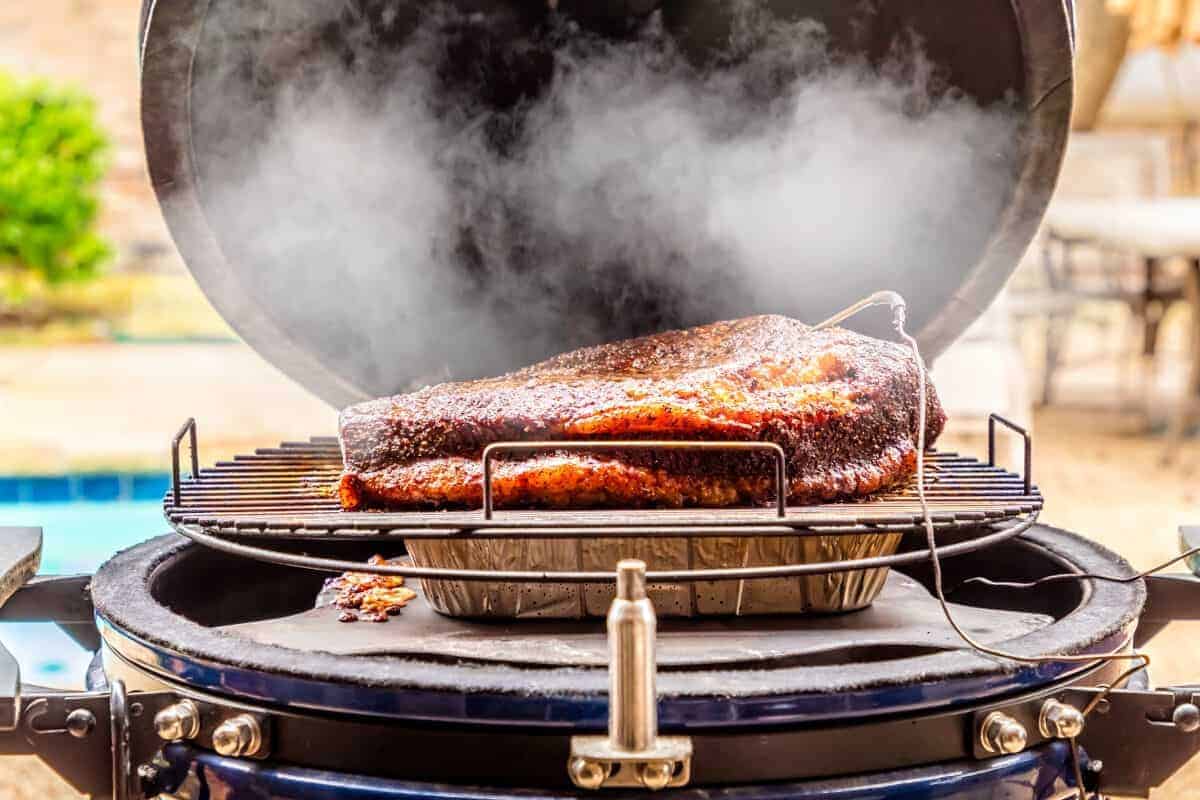
As the name implies, this method requires a low temperature, usually around 250F, held for a long time.
Cooking this way gives the meat a delicious crust and leaves the middle moist and juicy. Ribs and brisket are commonly cooked in this manner.
To do it, you'll either need indirect heat from your BBQ or, better yet, a dedicated smoker or combination grill and smoker such as a Kamado grill.
Smoking wood or pellets add savory flavors and aroma to low 'n' slow cooked meats.
Indirect Grilling/Roasting
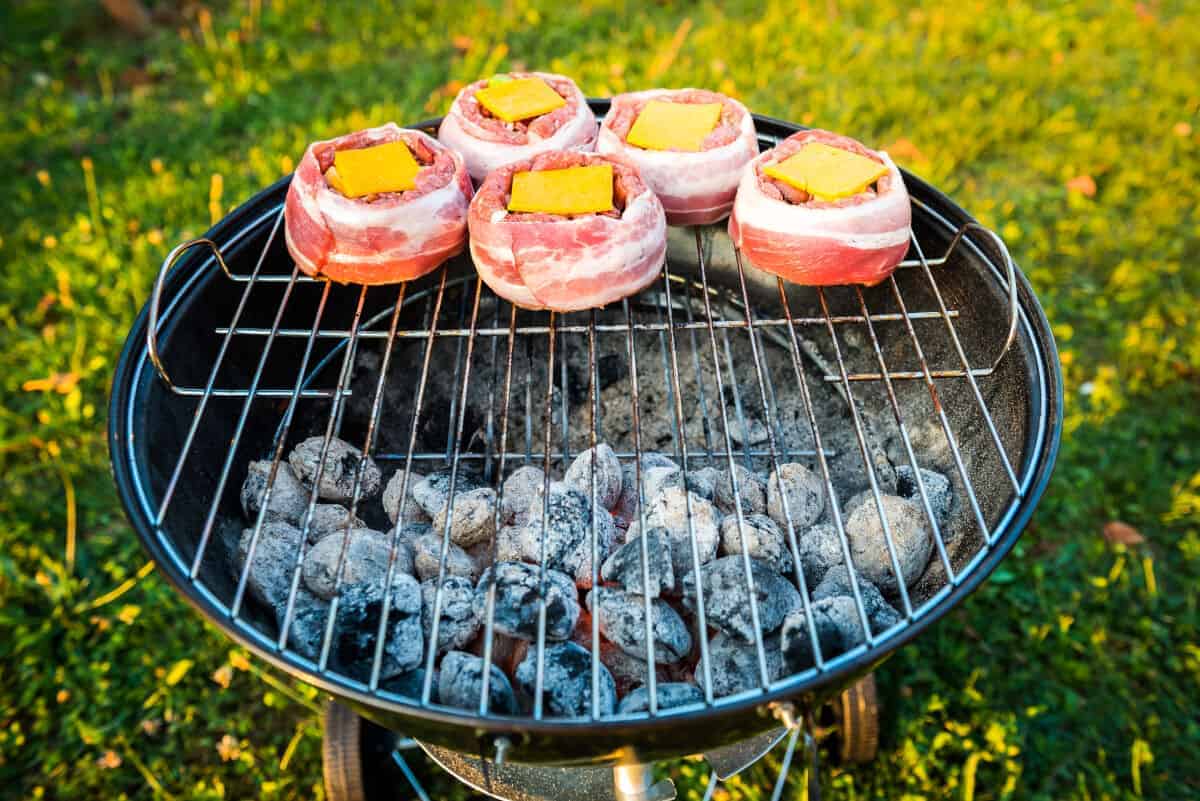
The biggest trap many grillers fall into is putting the meat over the fire and leaving it there. That's the quickest route to a dry and tough meal.
Indirect grilling allows meat to be close to the heat, but not directly over it. Slower grilling, or roasting, will cook meat to the desired doneness with precision and without burning.
Dutch Oven on the Grill
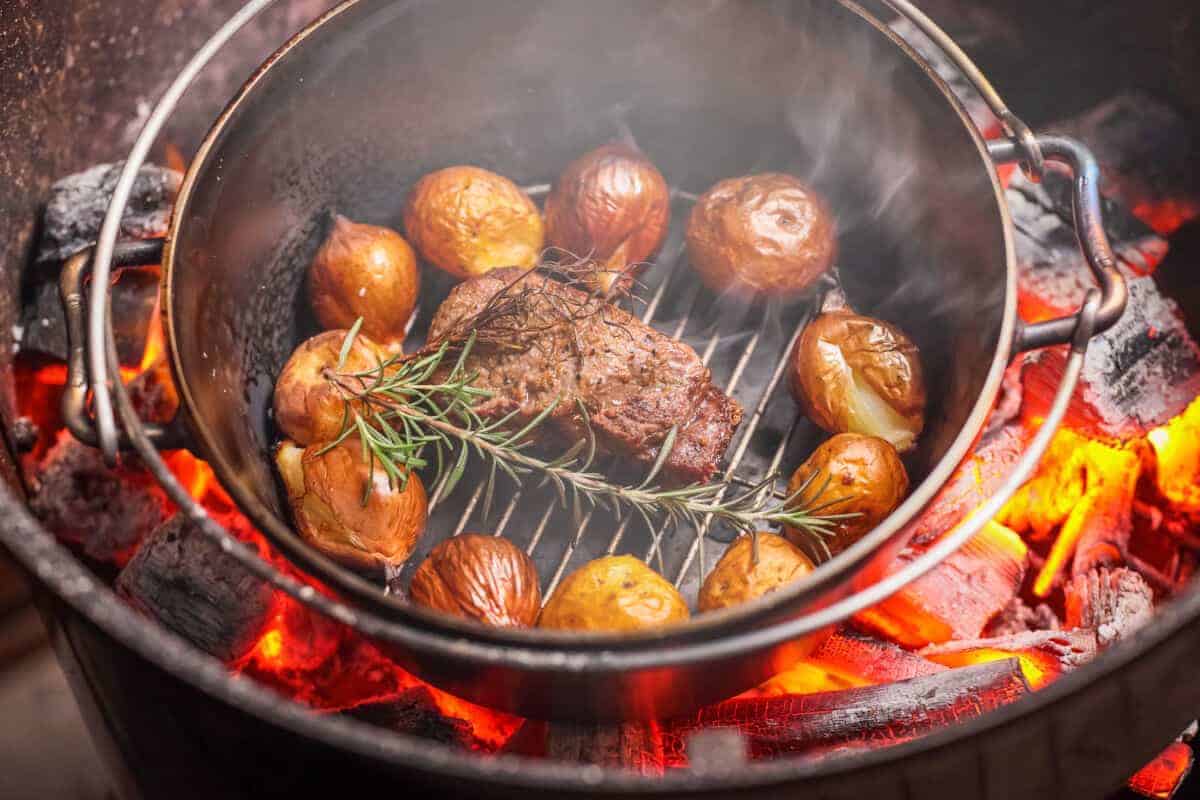
A Dutch oven is a kitchen staple and has been for many centuries. It's really not much more than a cast iron pot with a heavy, tight-fitting lid.
Cast iron holds heat very well and will tenderize tough meat with long and even cooking. Adding some fluid allows for braising on the grill.
Wok on the Grill
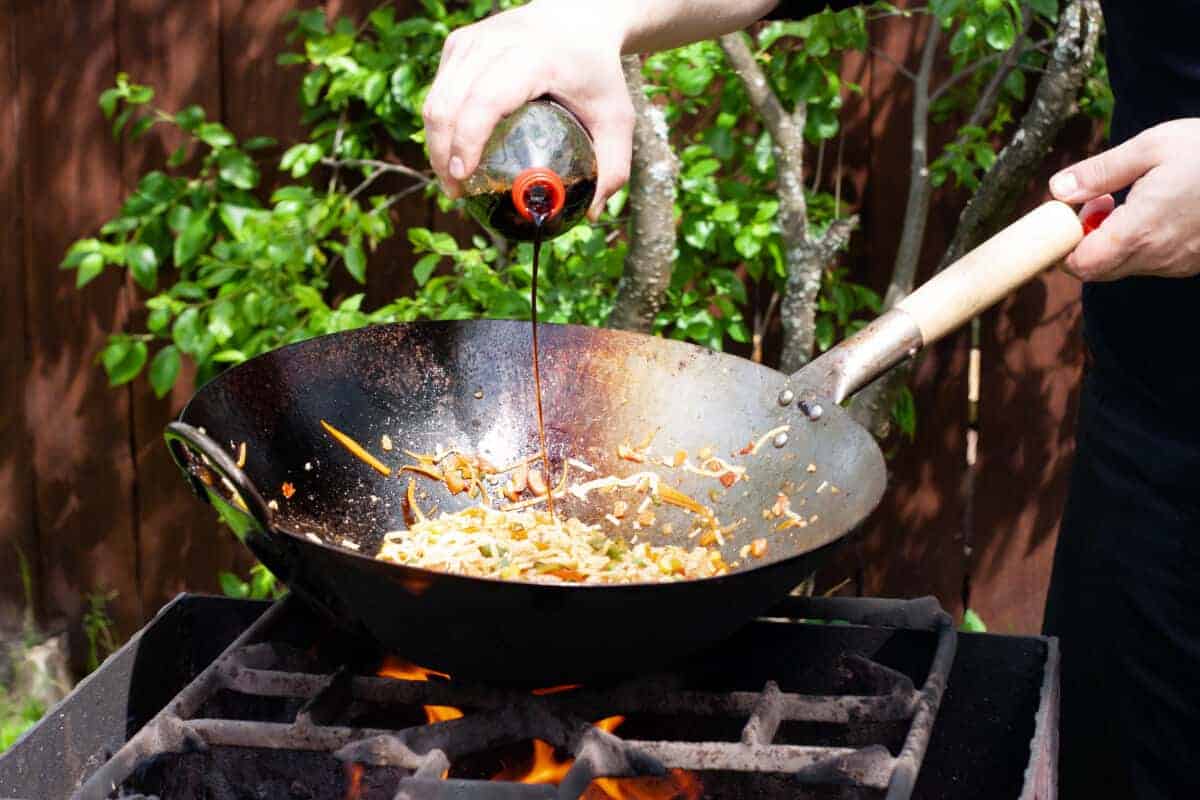
Do not misread this and try to walk on the grill. A good, cast iron wok is an excellent device for high heat cooking on a BBQ.
Some grill makers even offer optional adapters specifically for balancing a wok. Perfect for stir-frying chunks or strips of meat, and of course veg.
Texas Crutch
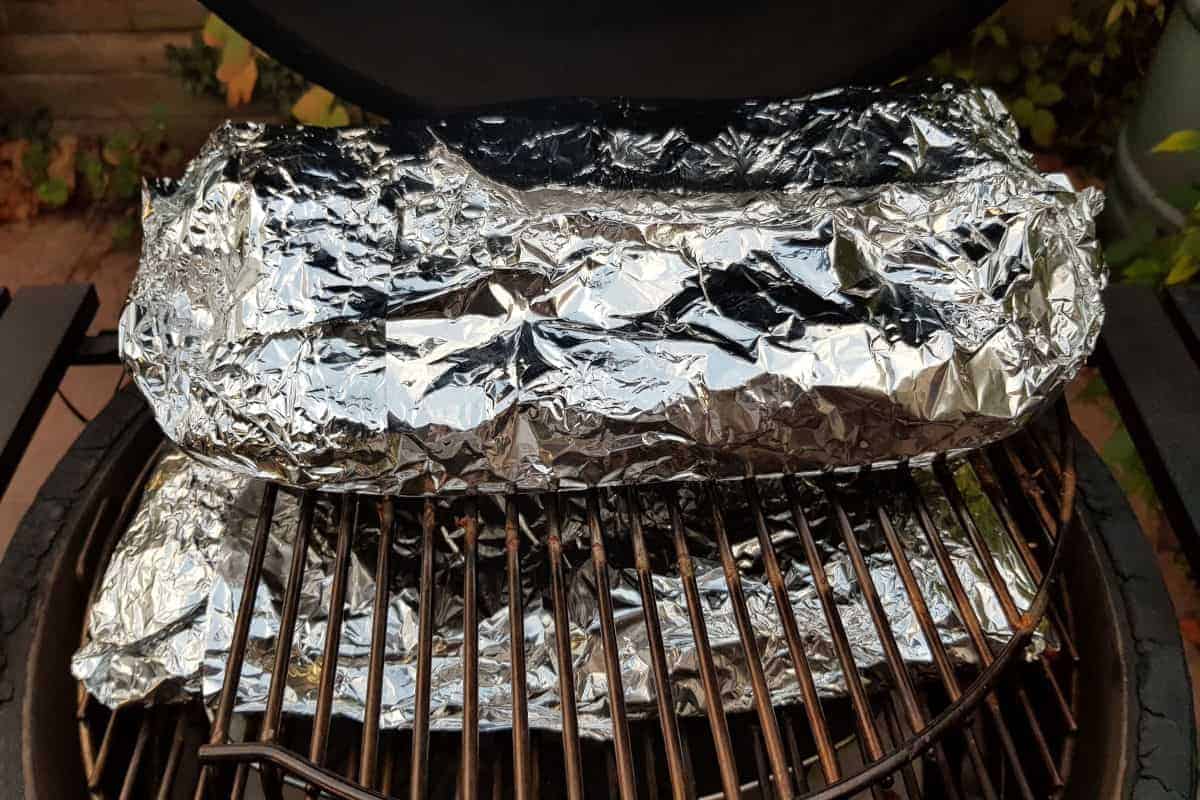
This is a technique used part way through low 'n' slow cooking where the meat is wrapped in foil, usually with added liquid, that tenderizes the meat and speeds up the cooking process.
During cooking at low temperatures, the bane of pitmasters the world over raises its ugly head: The dreaded BBQ stall.
During the stall, evaporative cooling keeps the meat from rising in temperature any further, and the cook effectively stalls. This can last for many hours.
By wrapping the meat in foil, magic happens. The wrap traps the moisture and steams the meat, evaporation stops and the meat temp continues to rise, the food continues cooking. And by coating the meat in a liquid before wrapping, usually a sauce of some kind, you tenderize the meat further and add extra flavor.
Taking Traditional Cooking Methods Outside to Your Grill
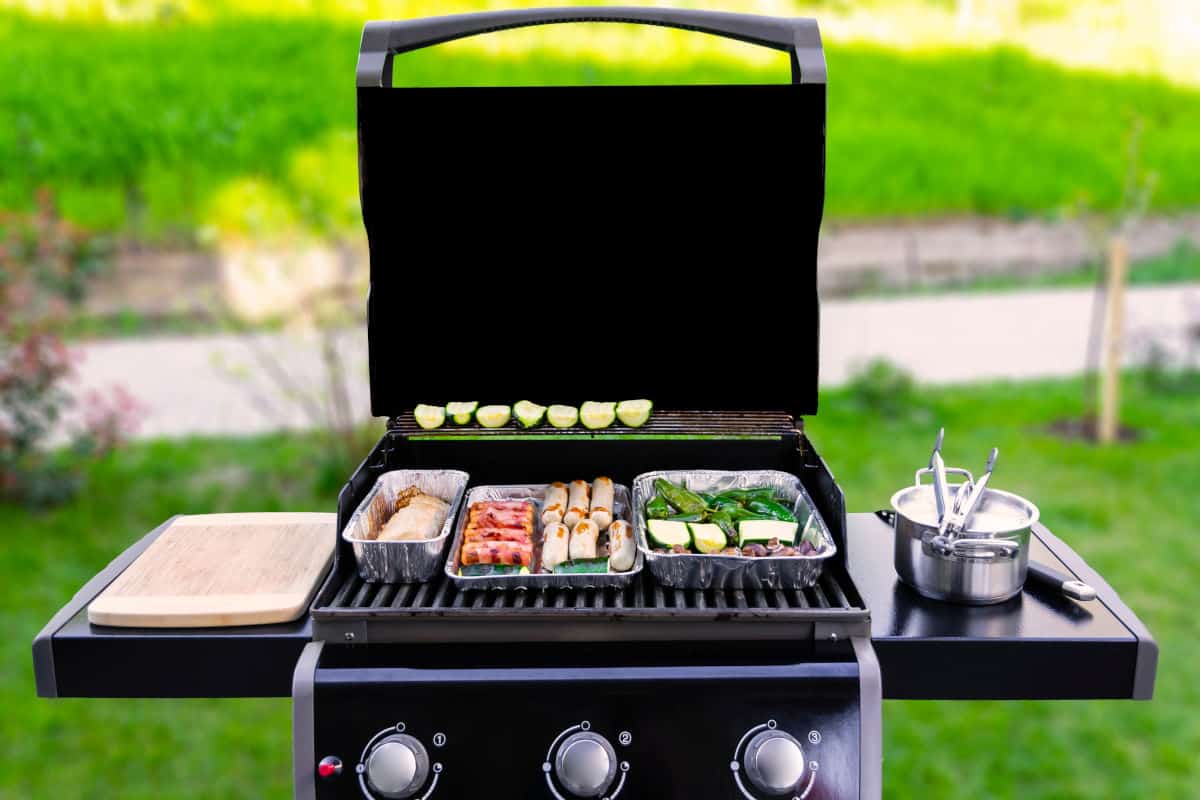
Many standard indoor cooking techniques can easily be adapted, or directly translated to, a technique of outdoor cooking.
Rather than puzzle over cooking instructions intended for the kitchen, use our Rosetta Stone of terminology to translate kitchen-ese to grill-speak.
Grilling or Broiling = Direct Grill and Sear
Grilling on a stovetop, and broiling in the oven are both high heat methods of cooking. They are good ways to sear or char meat for optimal Maillard crust, and are easily replicated in the backyard.
For any recipe that asks you to grill or broil in the kitchen that you wish to cook outdoors, simply place the meat directly over the charcoal or flames where the temperature is highest to cook a dish quickly.
Slow Cooking = Low 'n' Slow
Some cuts of meat turn out best when cooked slowly and evenly. An oven can be set to a low temperature to achieve this effect, but many people opt for the slow cooker instead, maybe the best indoor "set it and forget it" gadget to exist.
The same thing can be done outdoors, especially in a smoker, or Kamado grill. This is probably the best way to cook the toughest meats.
Simply set up your grill or smoker for indirect cooking, and keep the temperature at the figure quoted in the recipe.
Stir Fry = Cooking With a Wok on the Grill
A wok allows for rapid, high heat cooking with a minimum of oil. Many Asian dishes are prepared this way. A good quality cast iron wok can readily be used on most BBQs, providing yet another excuse to cook outside.
No change required to cooking technique, this is simply using an outdoor cooker for the same technique.
Roast = Indirect Grill and Roast
Oven roasting is a dry cooking method done at a medium-high temperature, usually around 400F. Often a light coating of oil is applied to help brown the food and give it a crust.
This technique can be duplicated on a grill by cooking over indirect heat away from the charcoal and allowing the meat to cook more slowly, though not as slowly as with low 'n' slow.
Match the temp of your grill to the recipes instructions for an oven, make sure the meat is off direct heat on your grill, and the same timings apply, but your results are better thanks to adding an authentic grilling flavor.
Skillet = Direct Grill and Sear
A cast iron skillet is a great way to sear or even char meat on the stove. Skillets get nice and hot and stay that way. Not suitable for delicate food, but great for a steak or chop.
Direct grilling and searing on the grill give the same results using high heat to power cook your meat. You could even use an actual skillet on your grill, if you really want to.
Skillet to Oven = Direct to Indirect Heat
Some dishes only cook to perfection and taste spot on if seared at high temperatures in a skillet before being moved to the oven to finish cooking the insides at a lower temperature.
Grillers know this technique well — just move the meat from direct heat to an indirect zone after the searing is complete.
Or, you can do reverse searing: Cook low 'n' slow first and then sear second by waiting until the meat is almost cooked on the indirect side before moving it to full heat to brown the surfaces.
Stewing or Pot Roasting = Searing and Finishing in a Dutch Oven
I love a tasty stew, and a juicy pot roast always hits the spot. Searing the meat before stewing or pot roasting adds a little extra flavor and texture.
You can achieve the exact same thing on the grill, by searing over direct heat and then transferring the meat to your Dutch oven, before letting it cook in its own juices, a gravy, or perhaps your own secret sauce. (Which I expect to get the recipe for!)
Braise = Low 'n' slow, OR grill and Texas Crutch, OR Braise in a Dutch Oven
Braising is not unlike Pot Roasting, but true foodies will insist there's a difference. It's a great technique for turning tough, inexpensive meat into a gourmet meal.
To braise meat, you'll need time and moisture. Low 'n' slow provides the time, and the moisture loss is low with this style.
To accomplish the same outdoors, you can straight up grill the meat and then go to Texas Crutch with some added fluid for moisture, or toss it in the Dutch Oven to cook in sauce, gravy, beer, wine, or whatever your recipe (or imagination!) calls for.
The Final Cut
Still with me? Well, a side of beef is a lot of terrain to cover, so good on you for seeing it through.
Beef has a lot to offer the barbecue lover, and there's something to please every palate. Knowing your beef cuts and what to do with them allows you to make better choices at the grocery store or butcher shop.
Perhaps you'll now find the courage to tackle some cuts you might otherwise have avoided, or you've discovered a new cut to try?
It's all about good fun and good eats when you fire up the grill or smoker, and we hope you've found something here to pique your interest.
We always welcome your questions, comments and even corrections, so please drop us a line if you've got something you want to tell us.
And, if you've got a friend who's also a fan of the beef, don't keep this treasure trove of knowledge to yourself — share it far and wide, and make some beef happen in your neighborhood.
Source: https://www.foodfirefriends.com/beef-cuts/
0 Response to "Which Meat Is Better the Back or Rear of a Beef"
Post a Comment